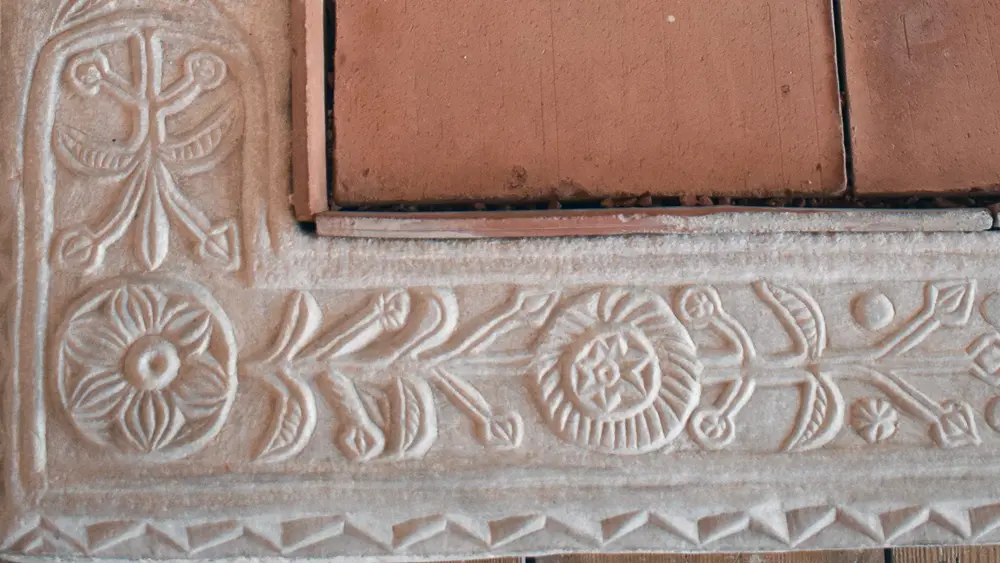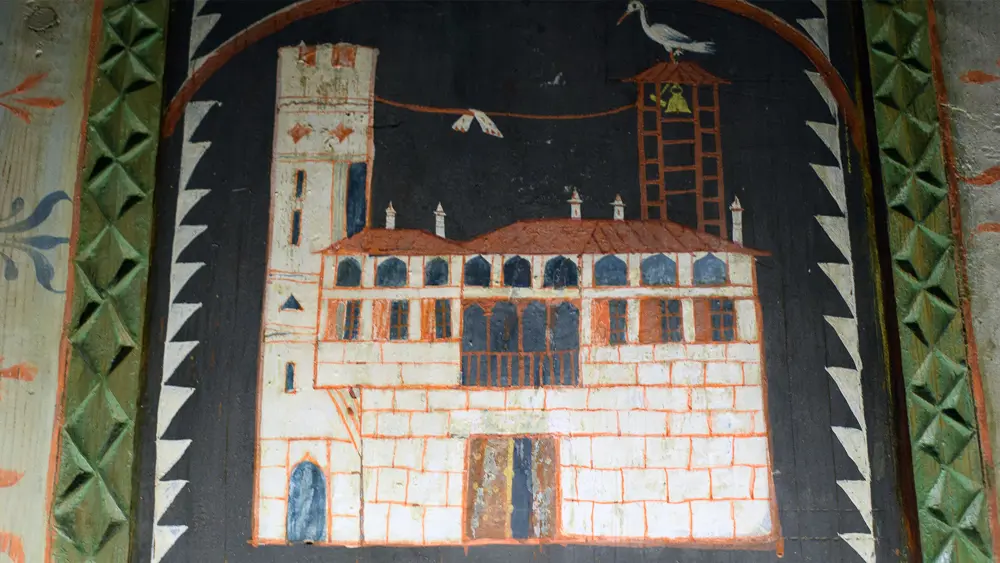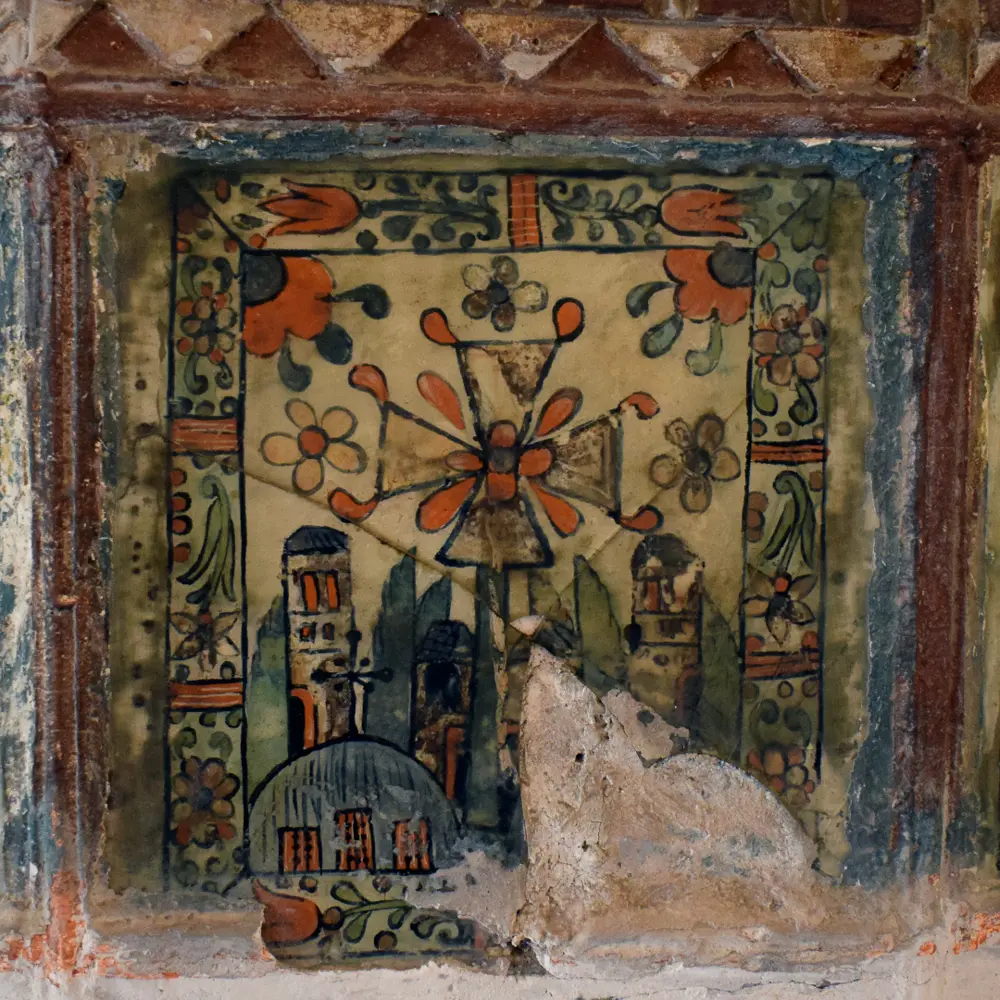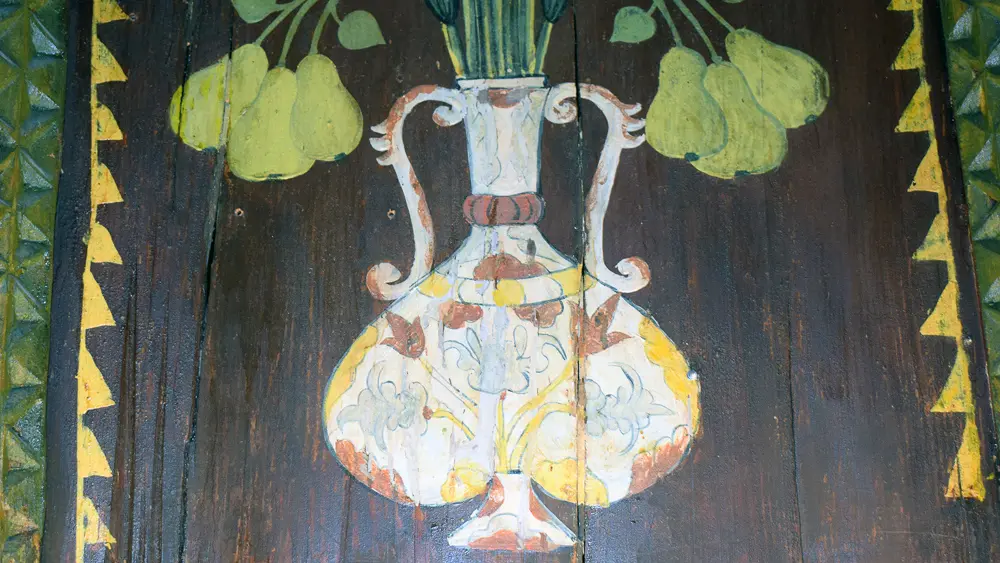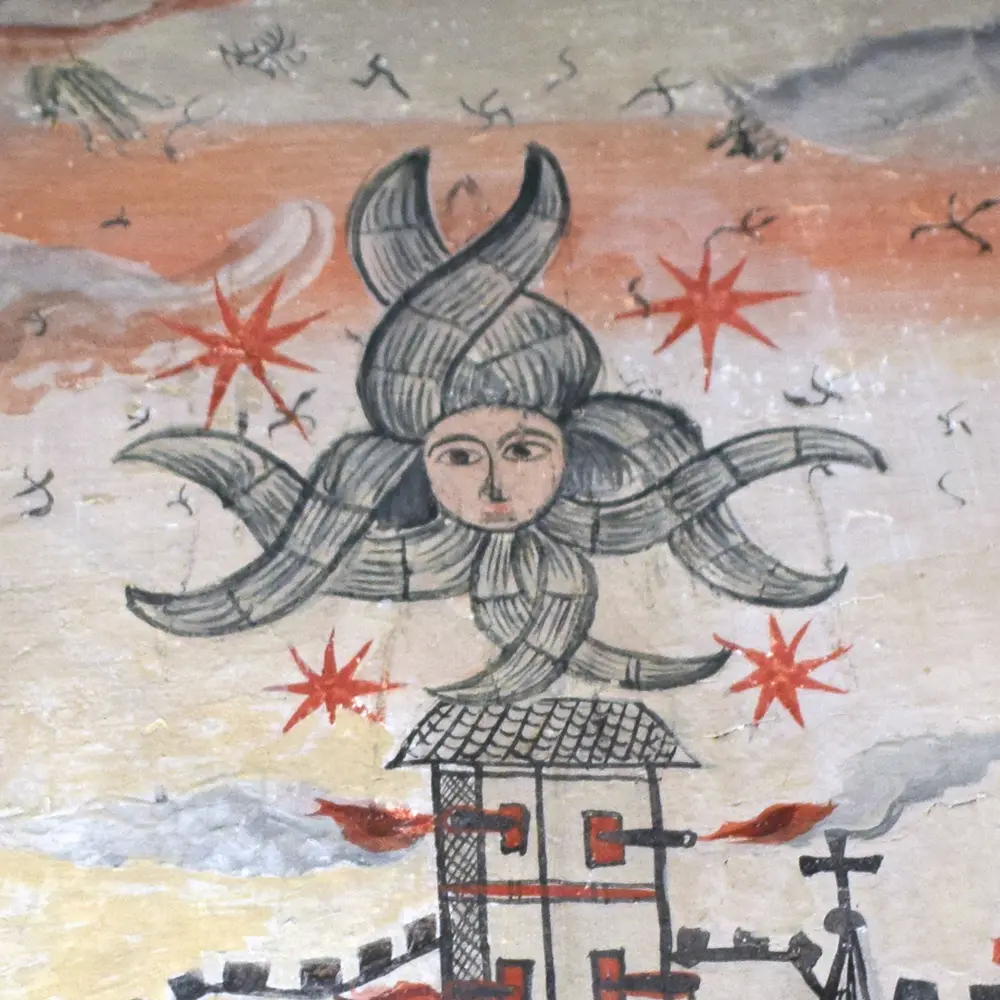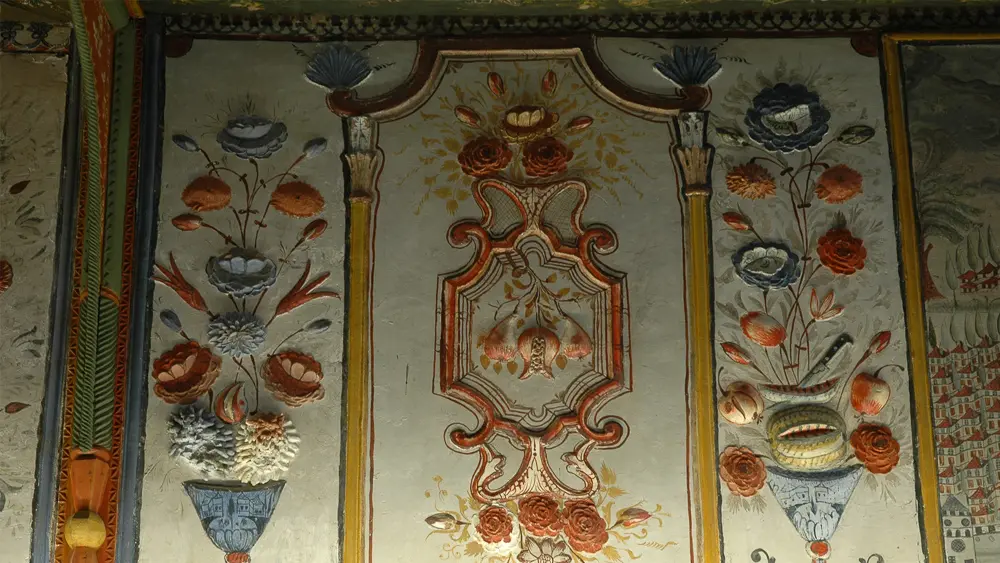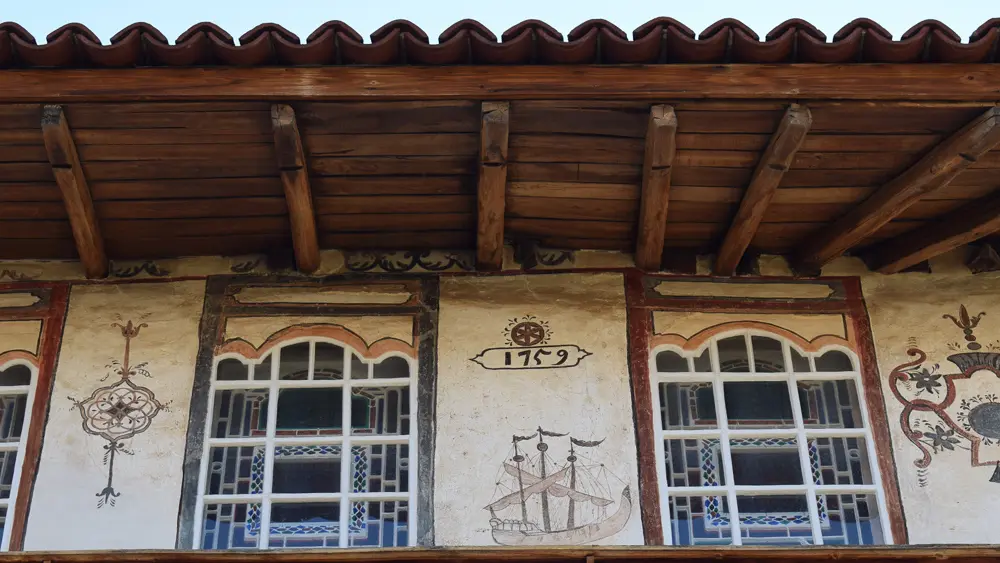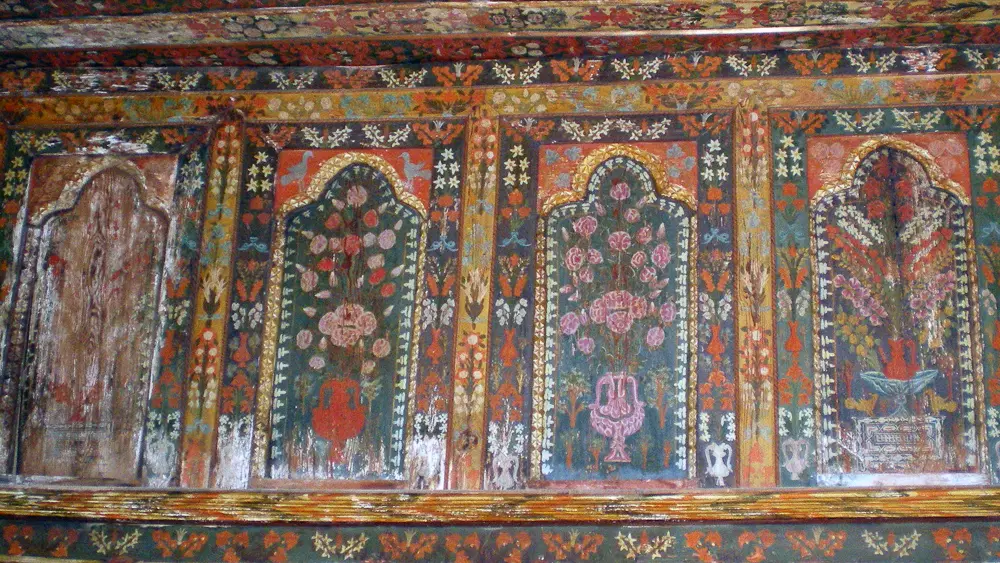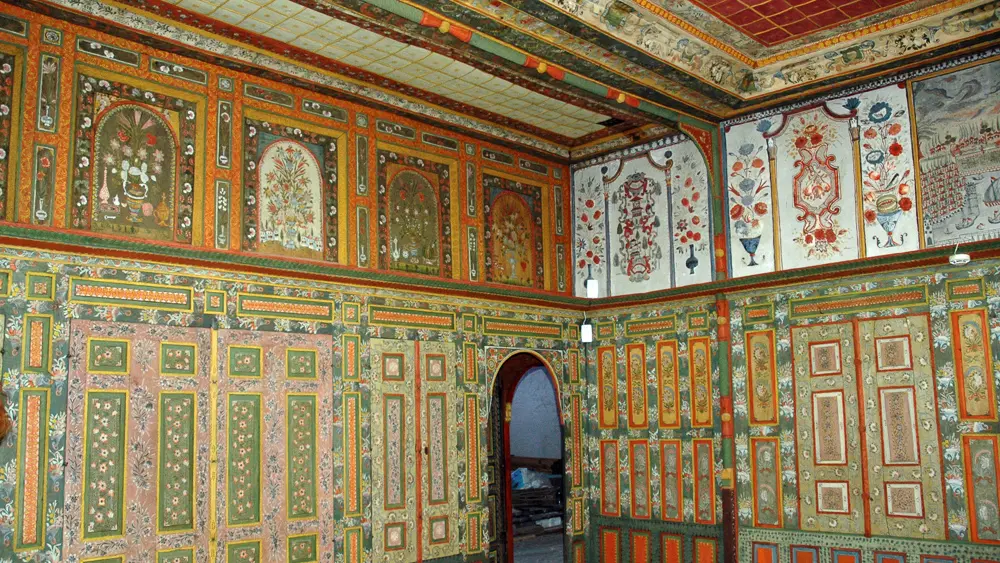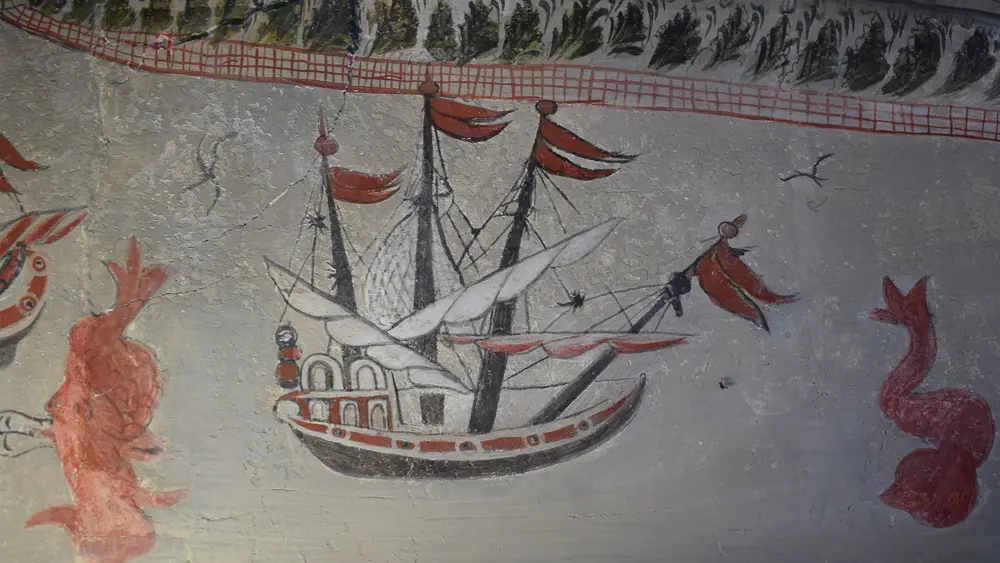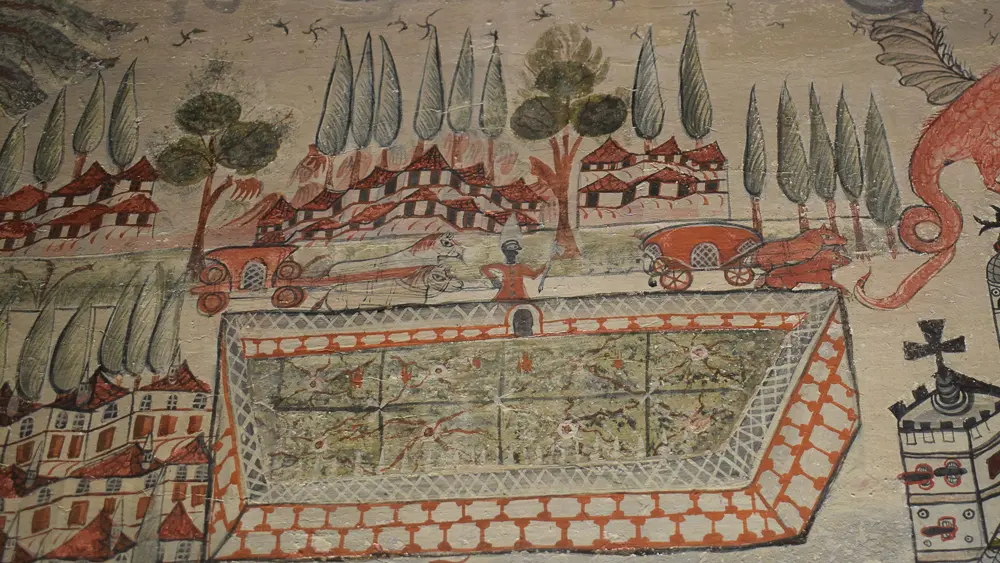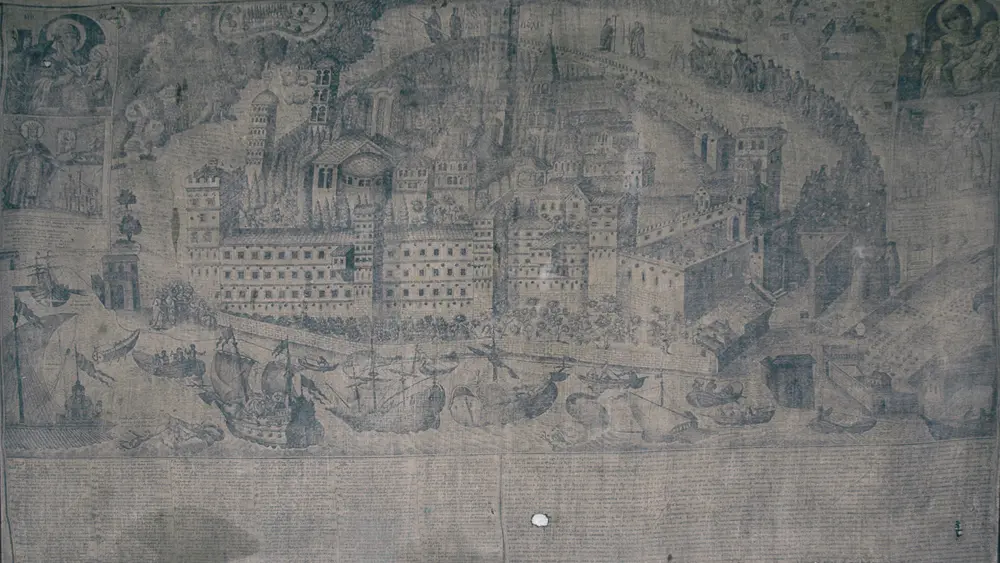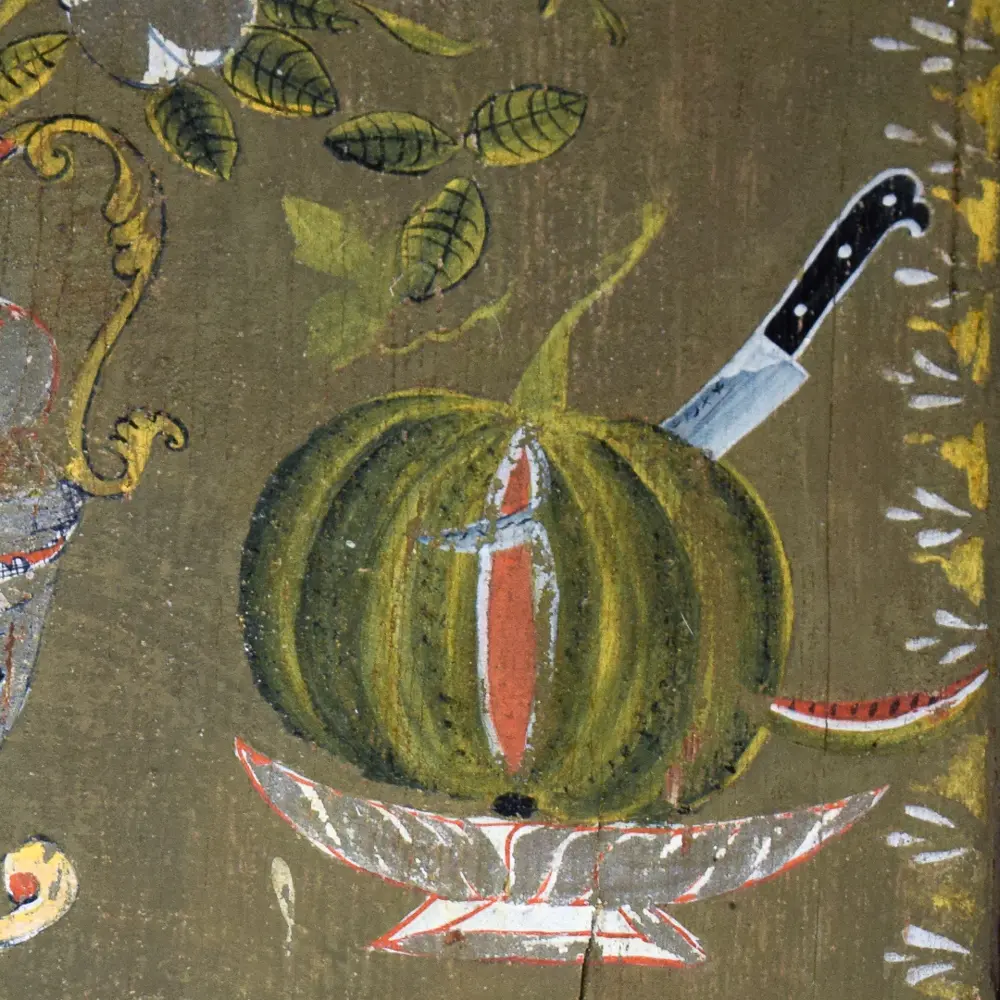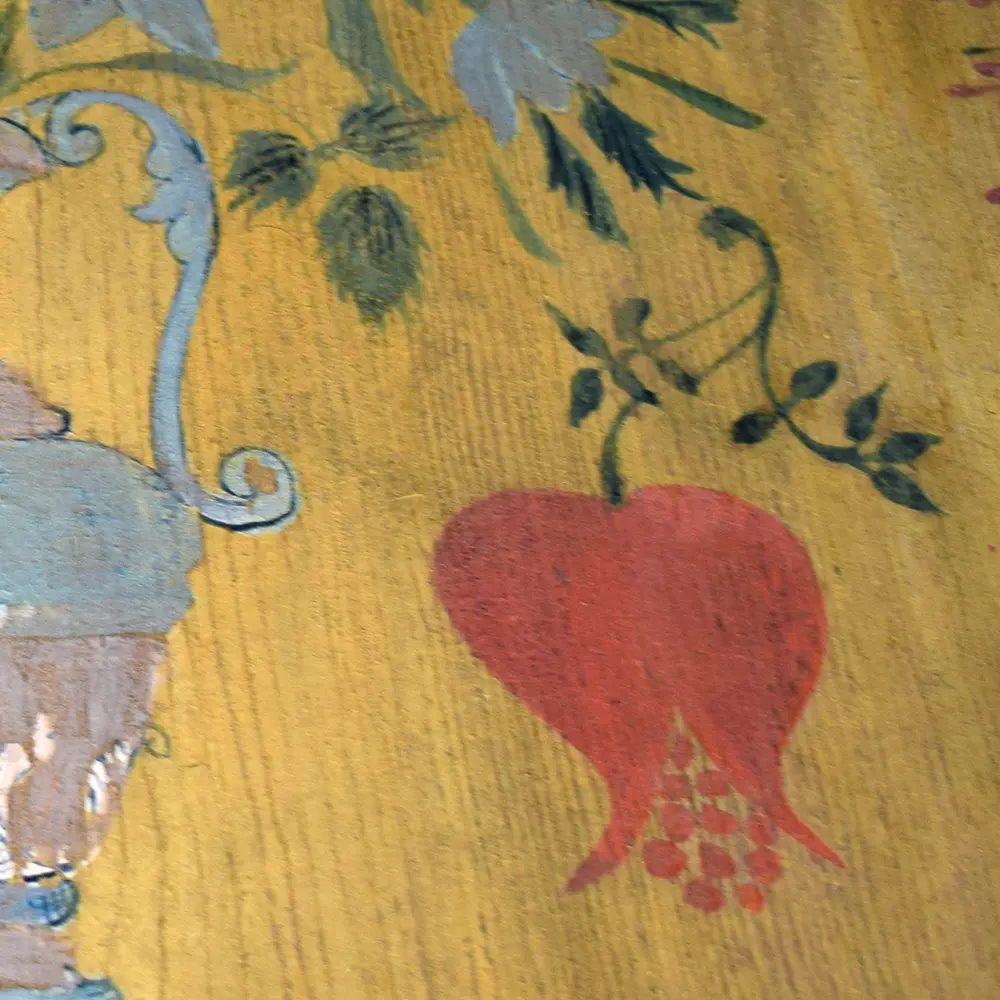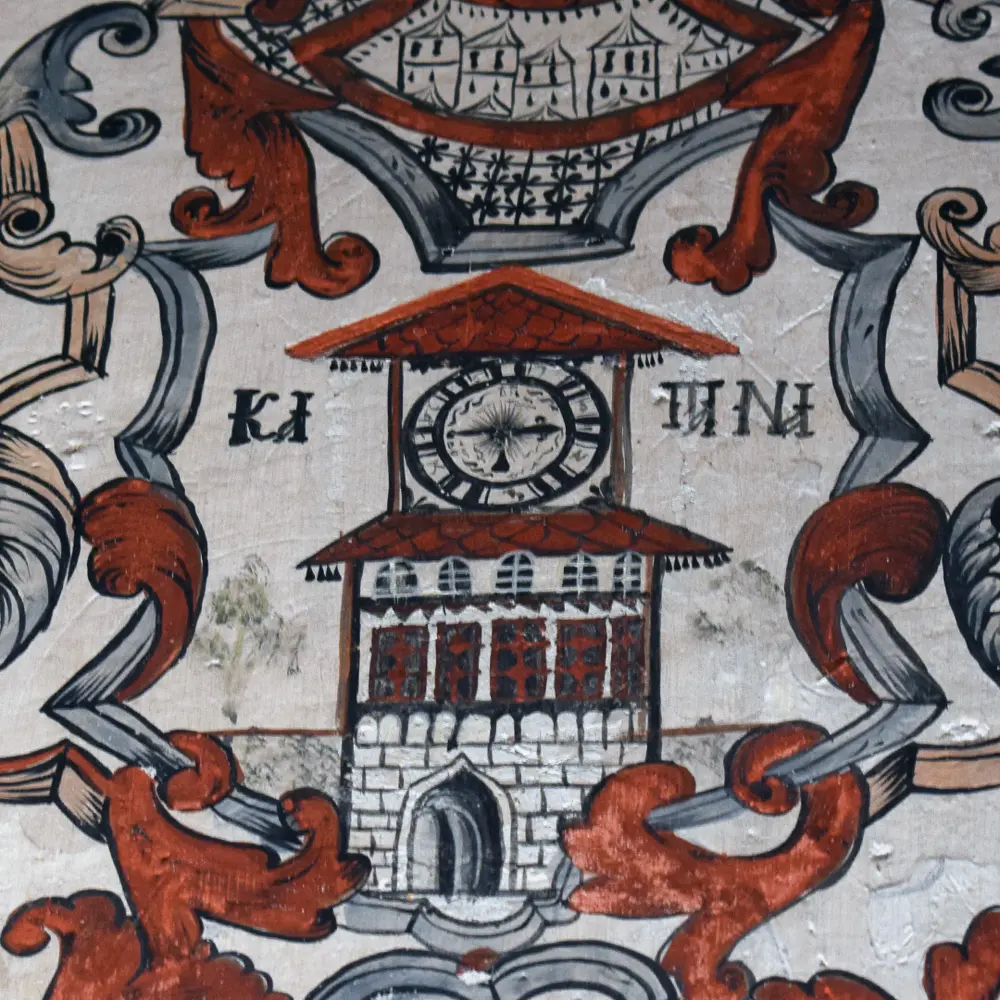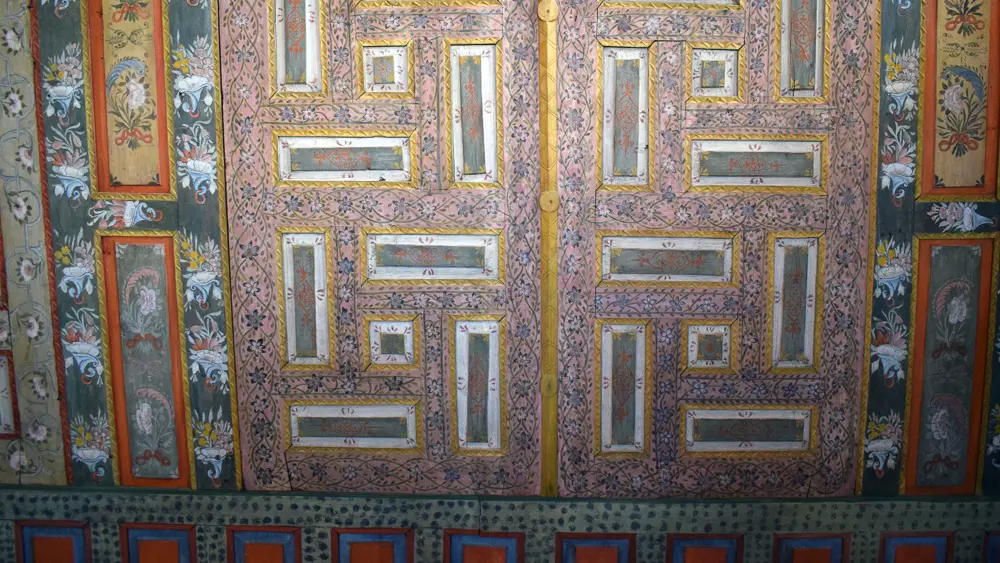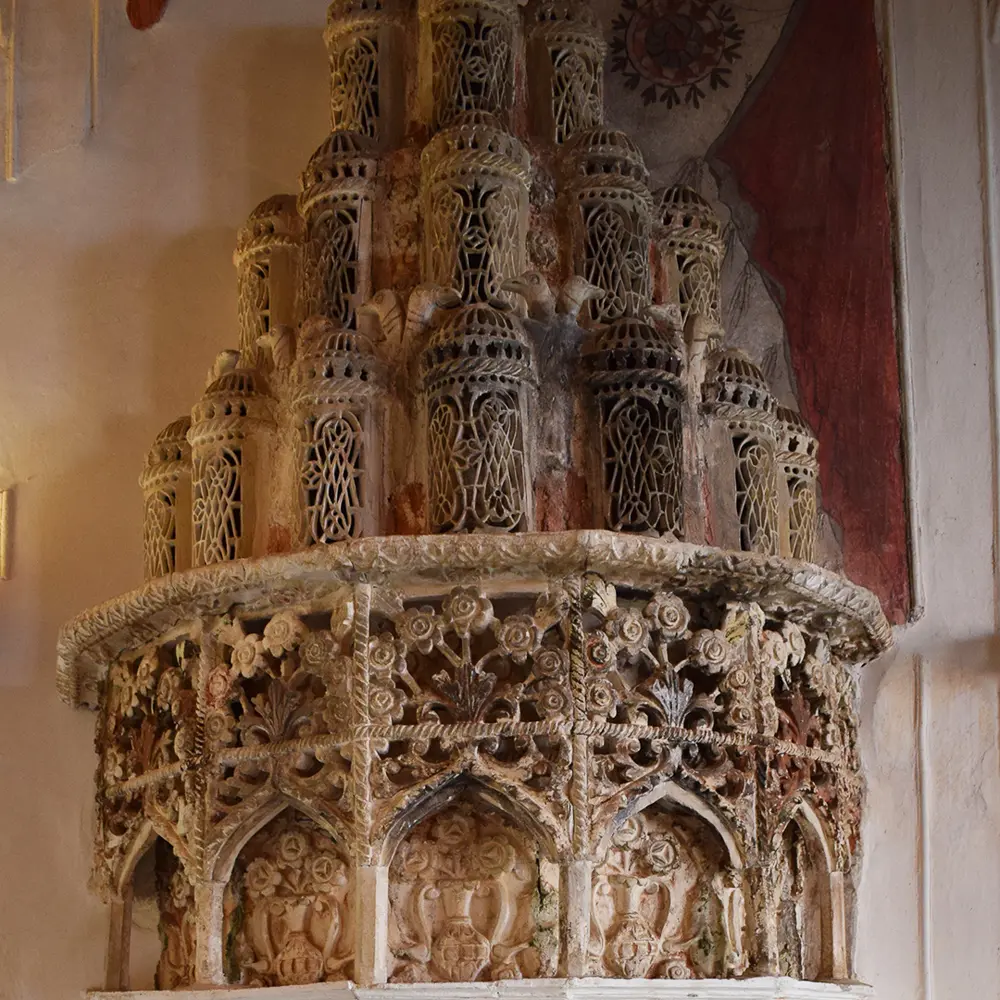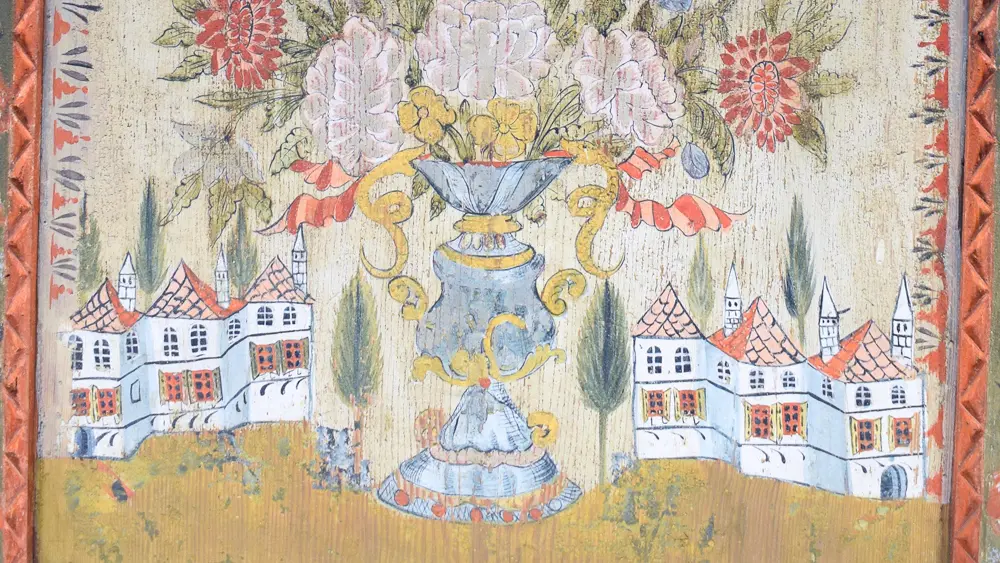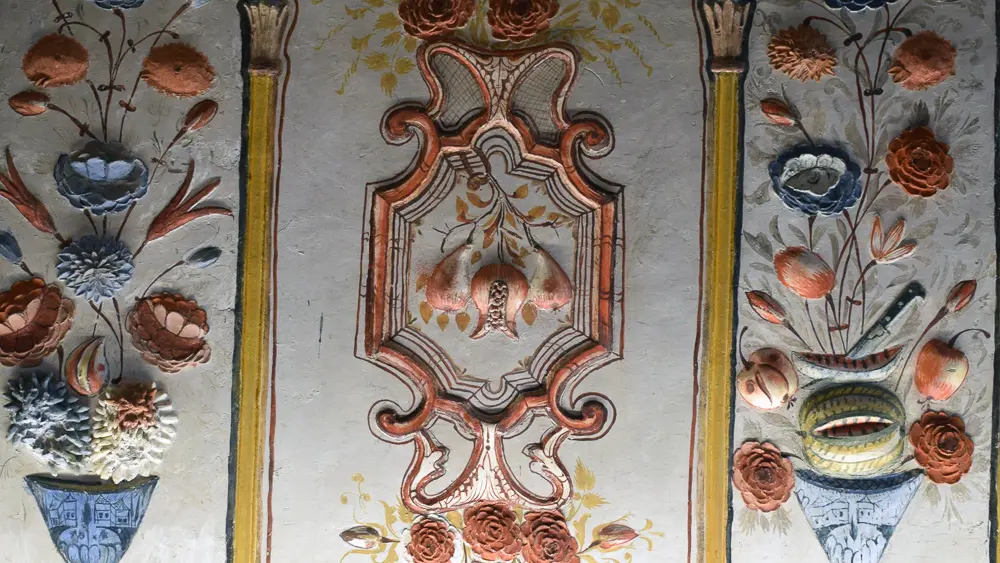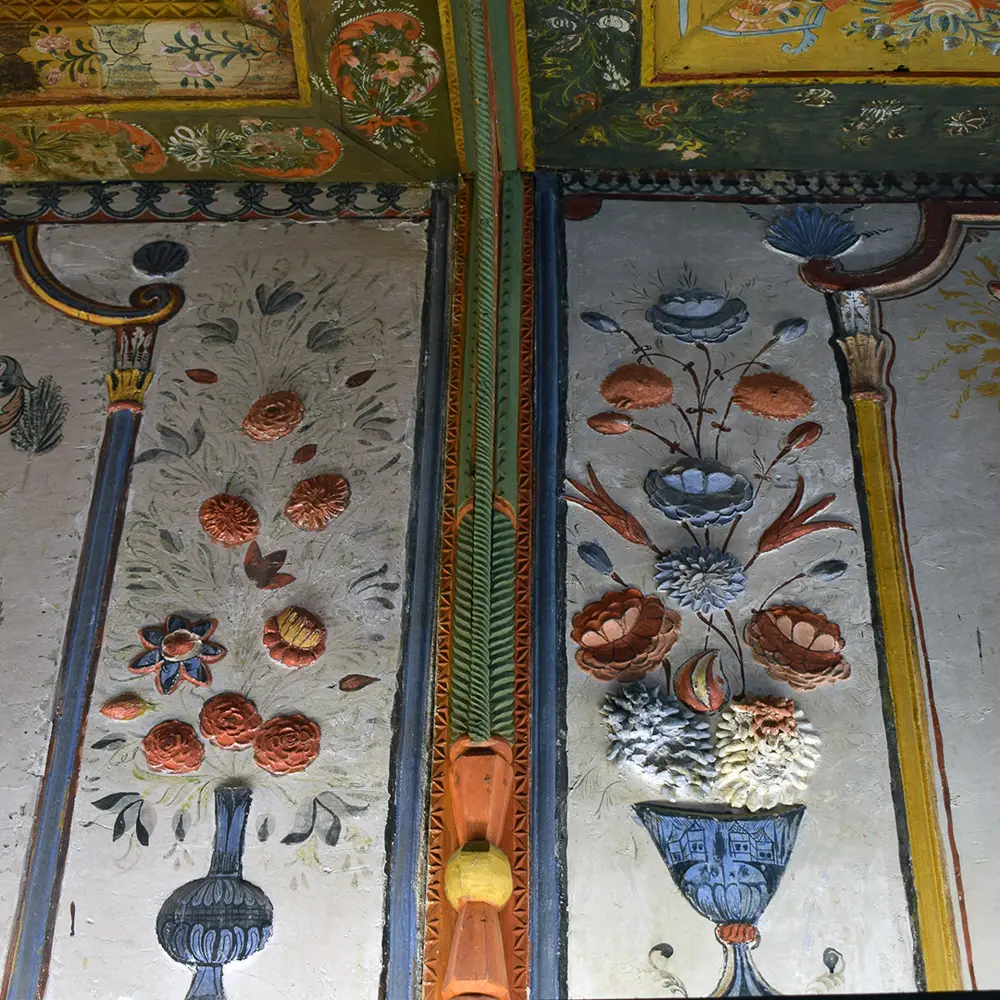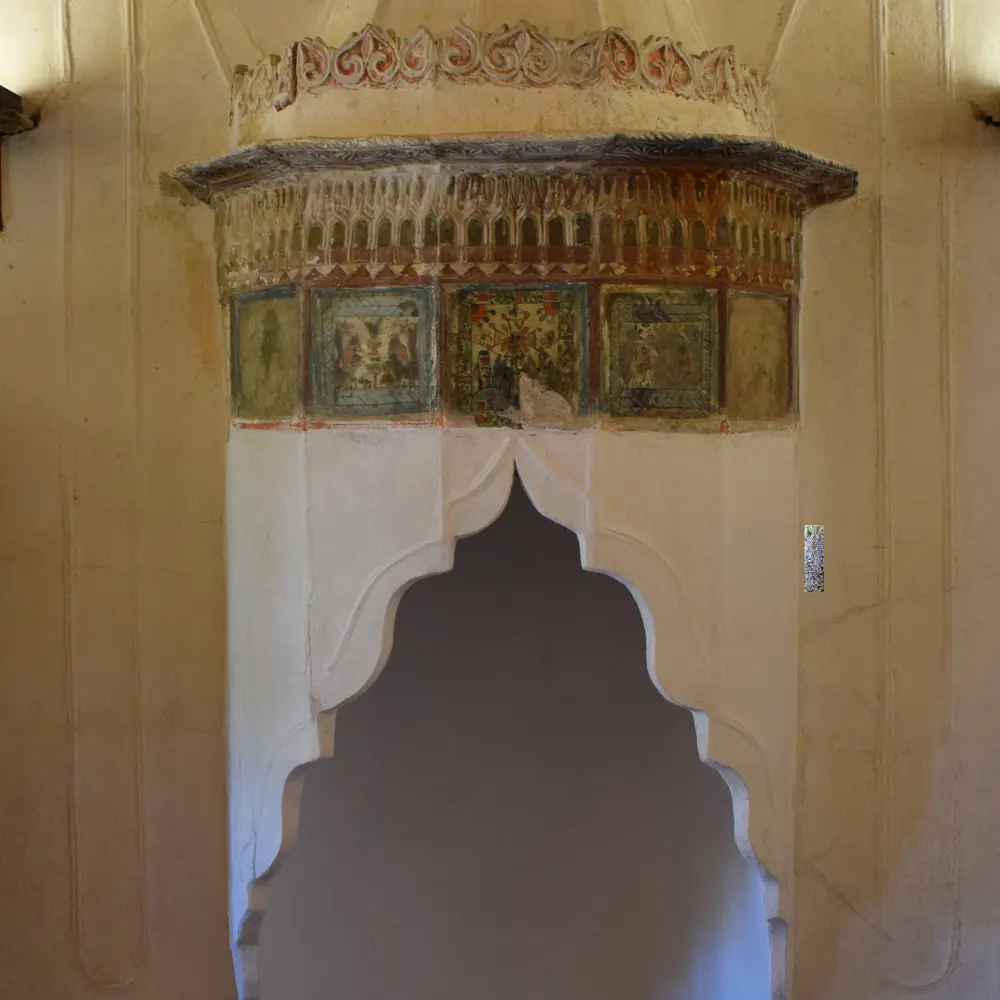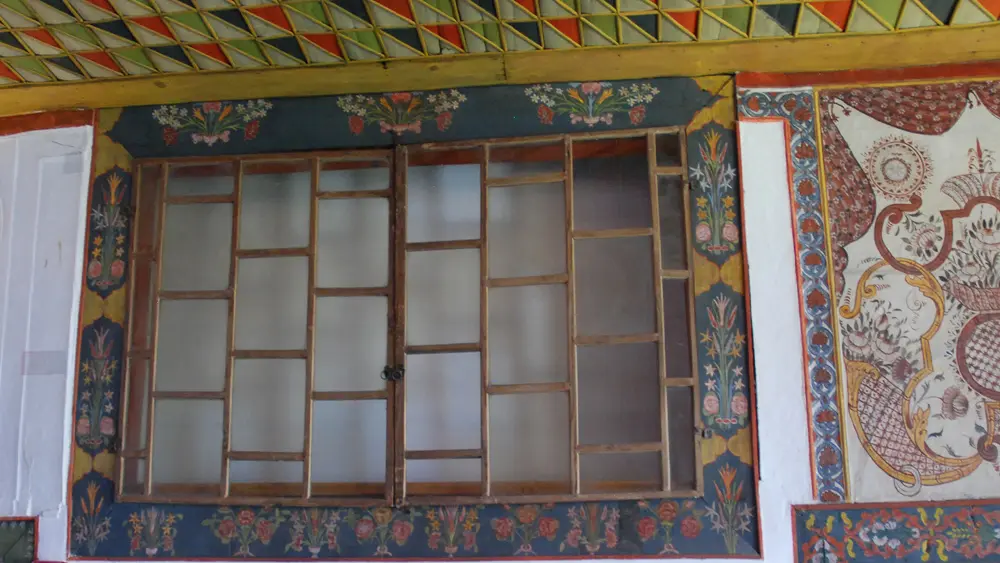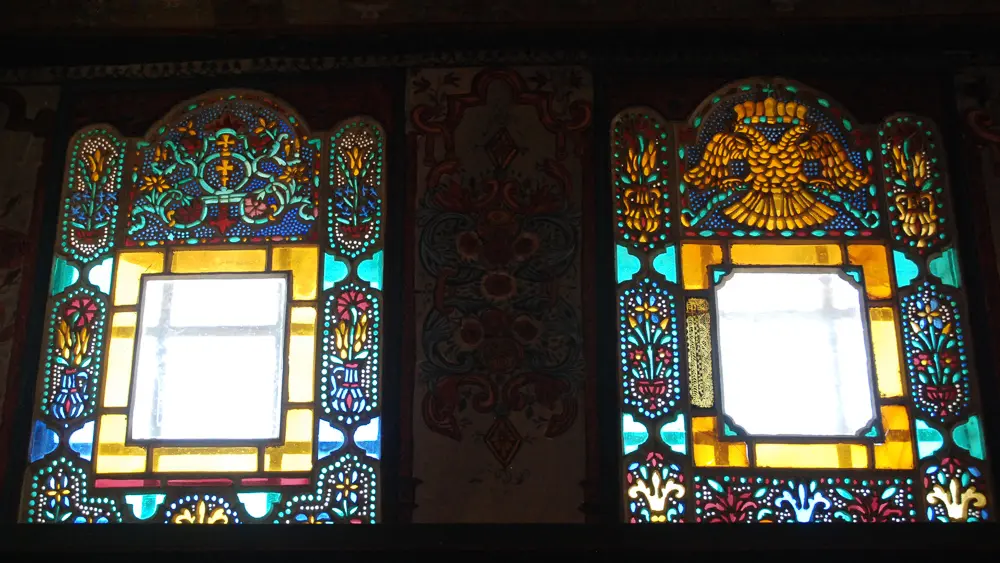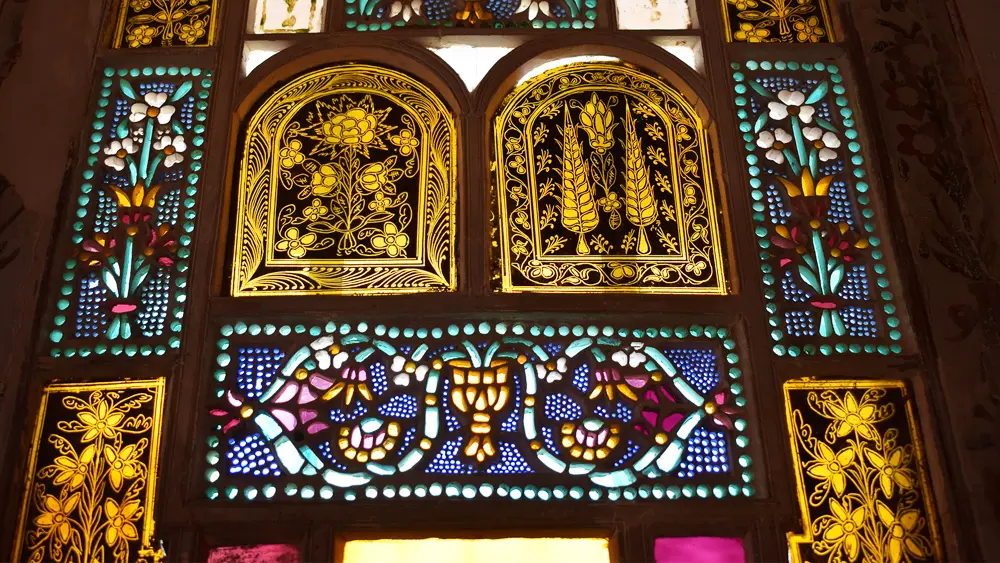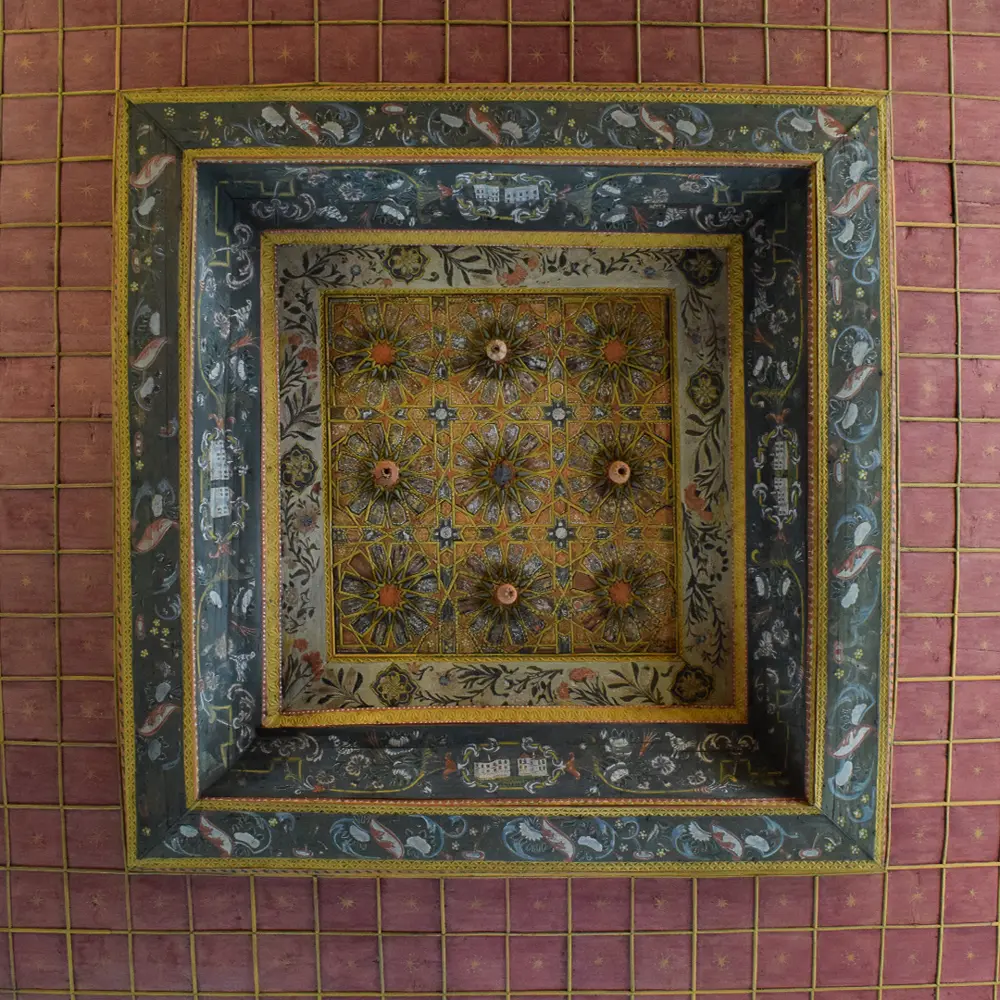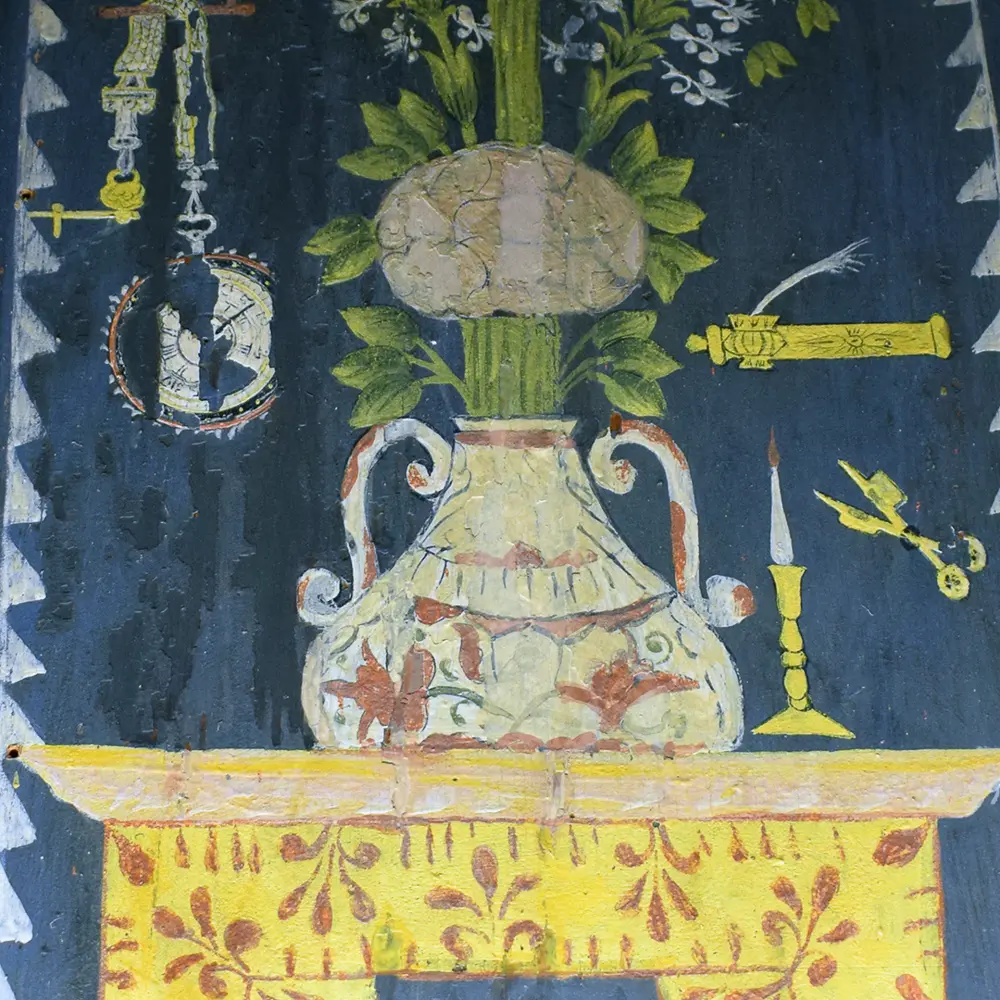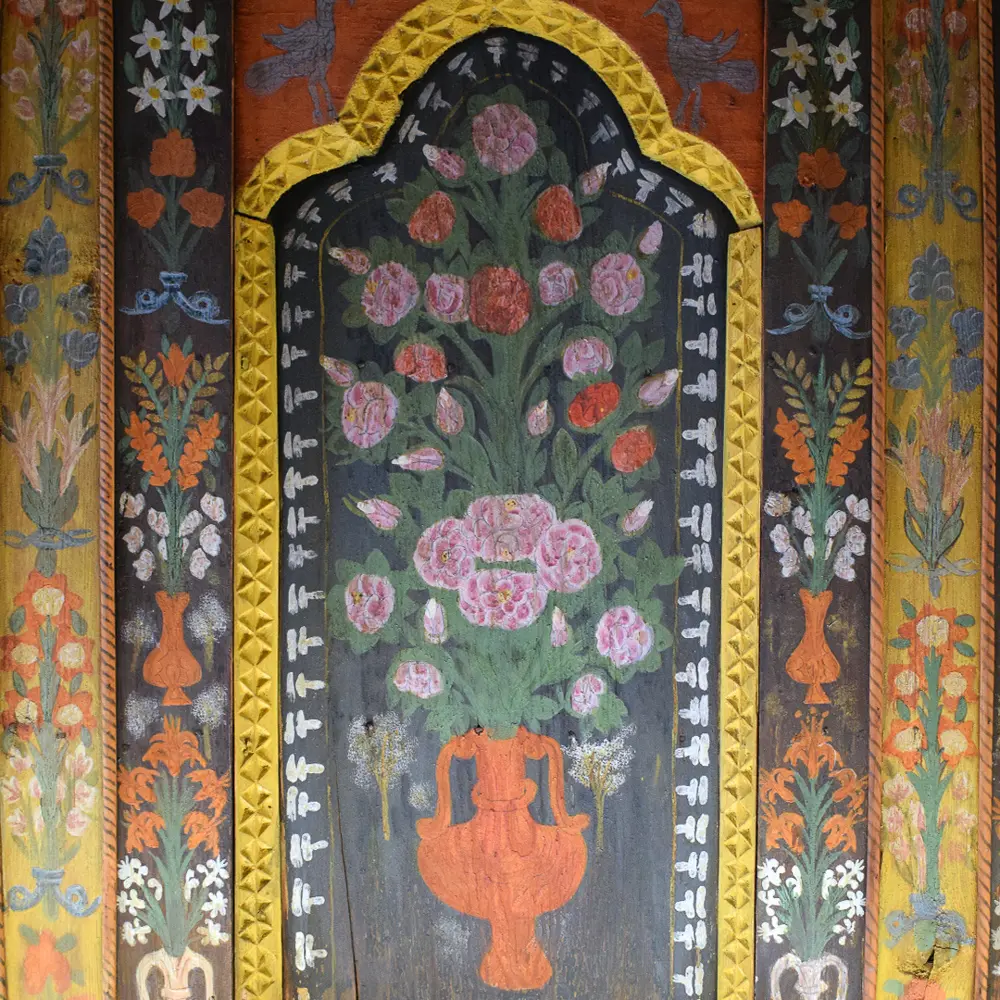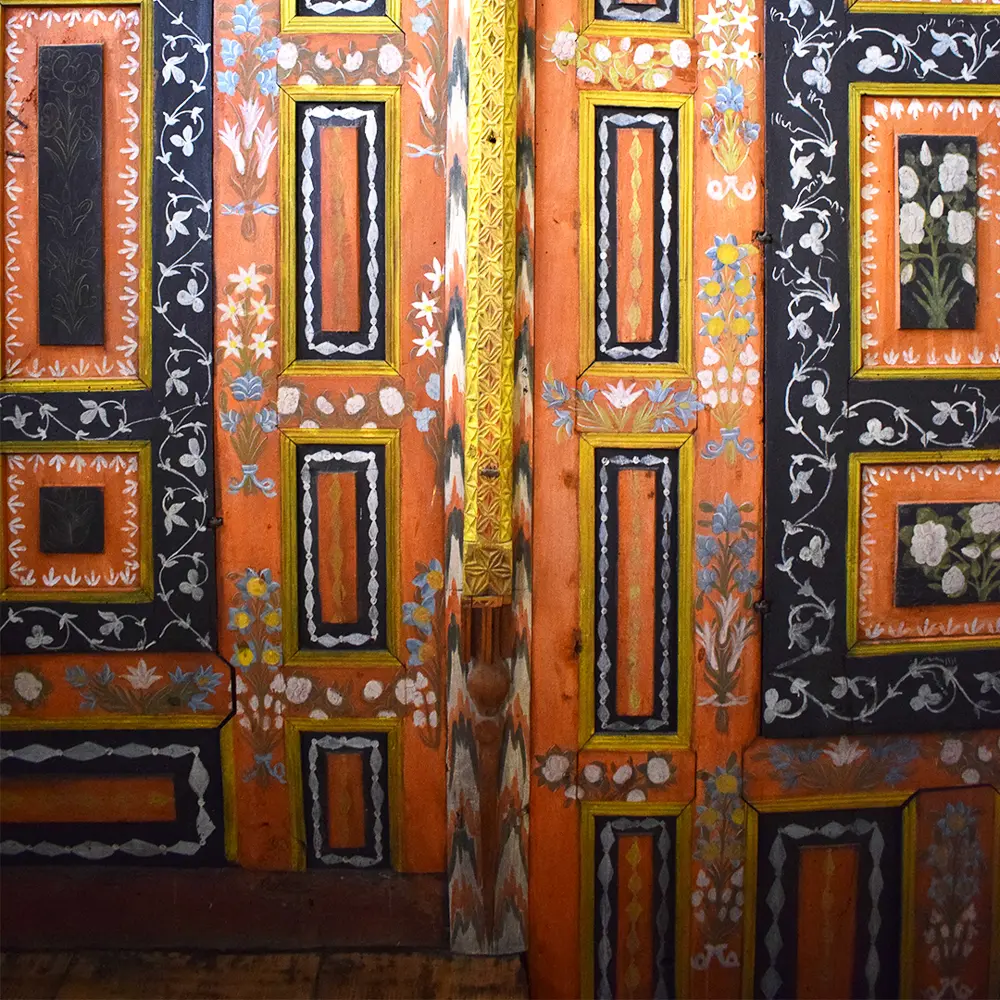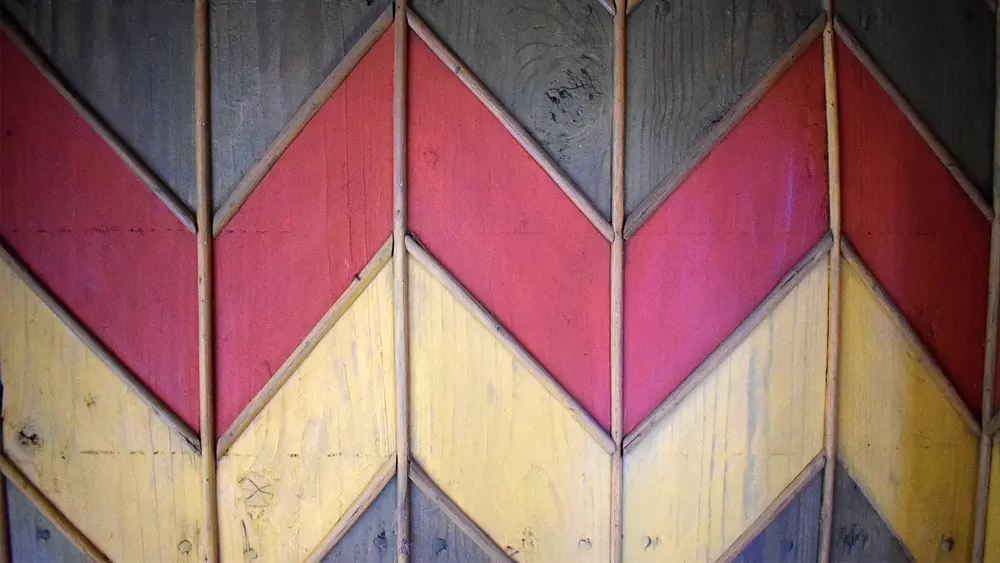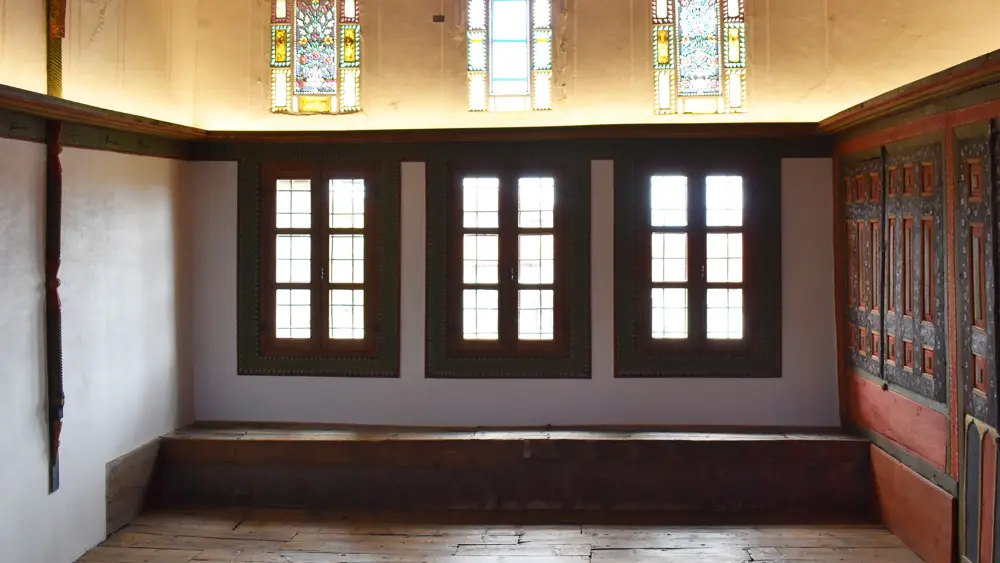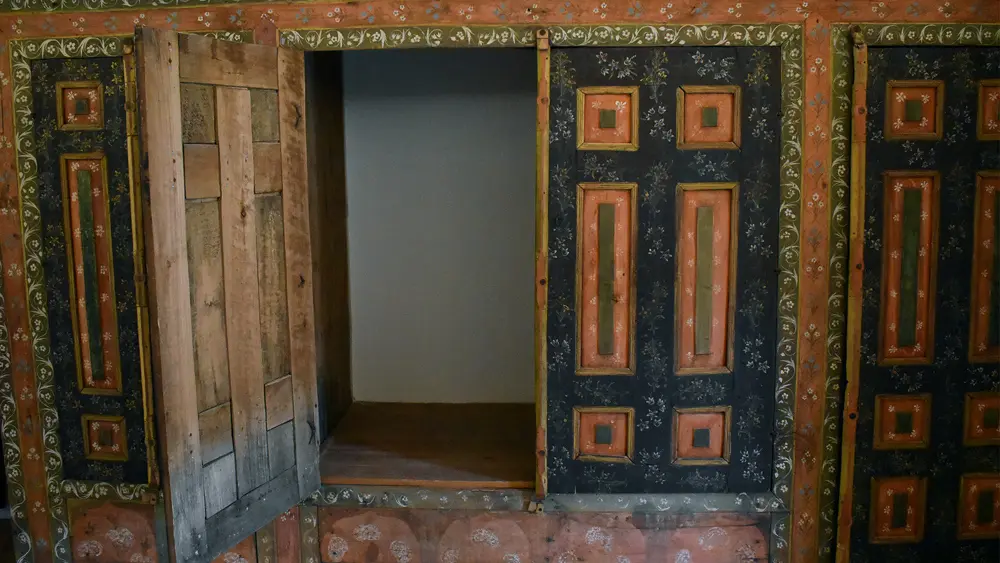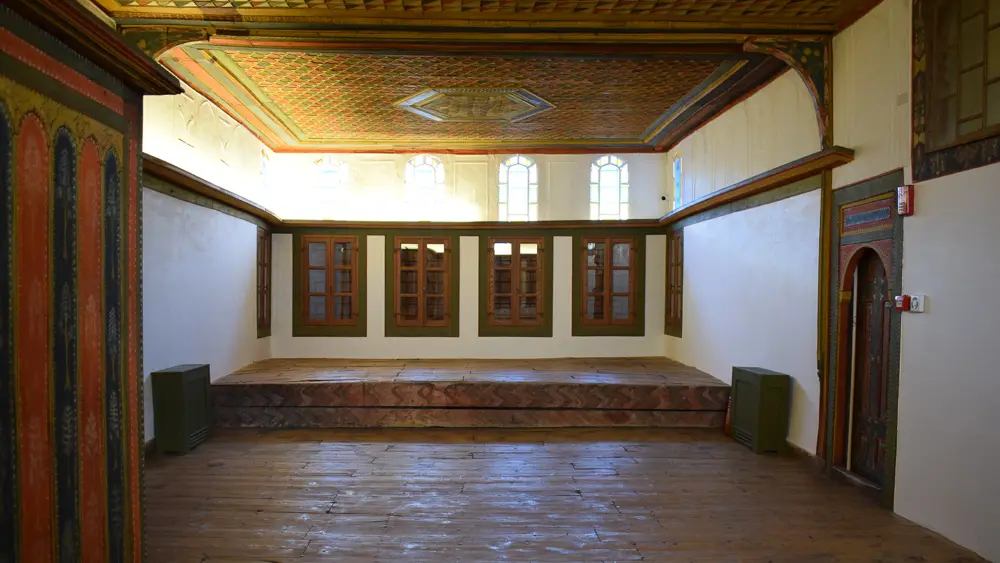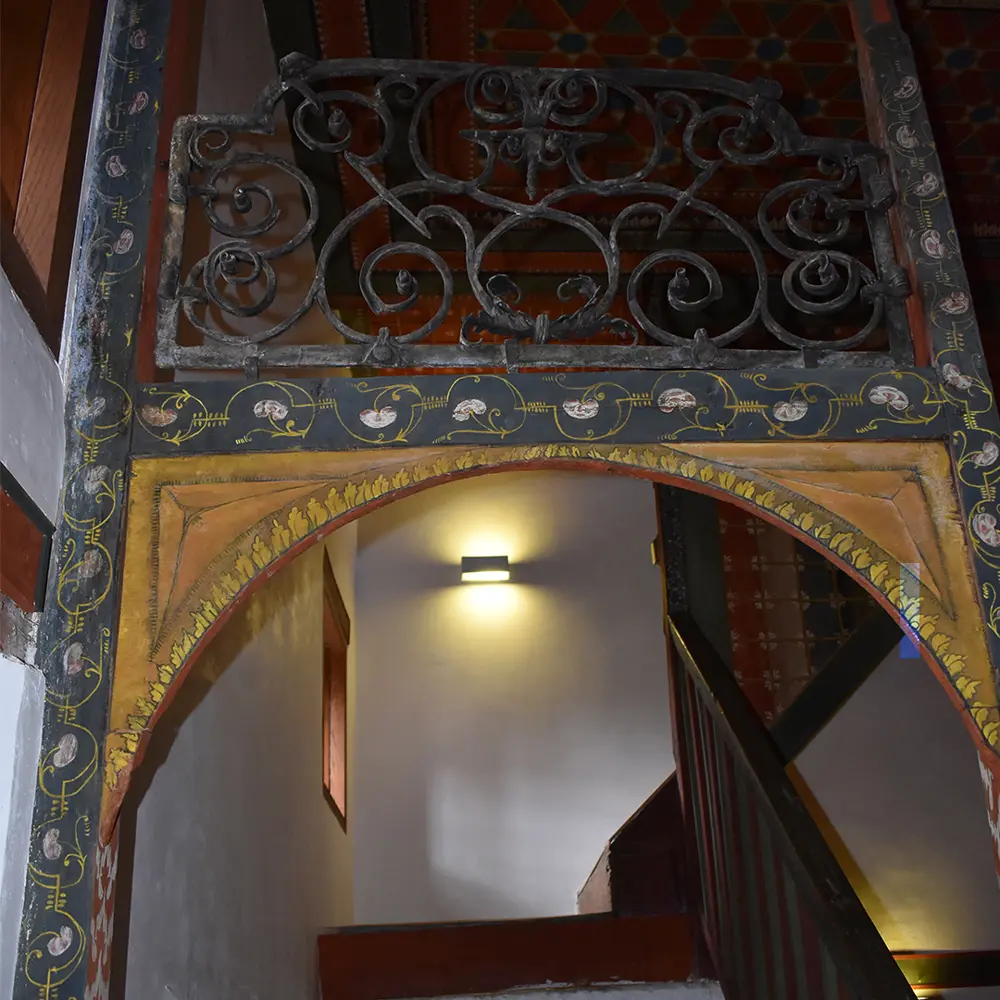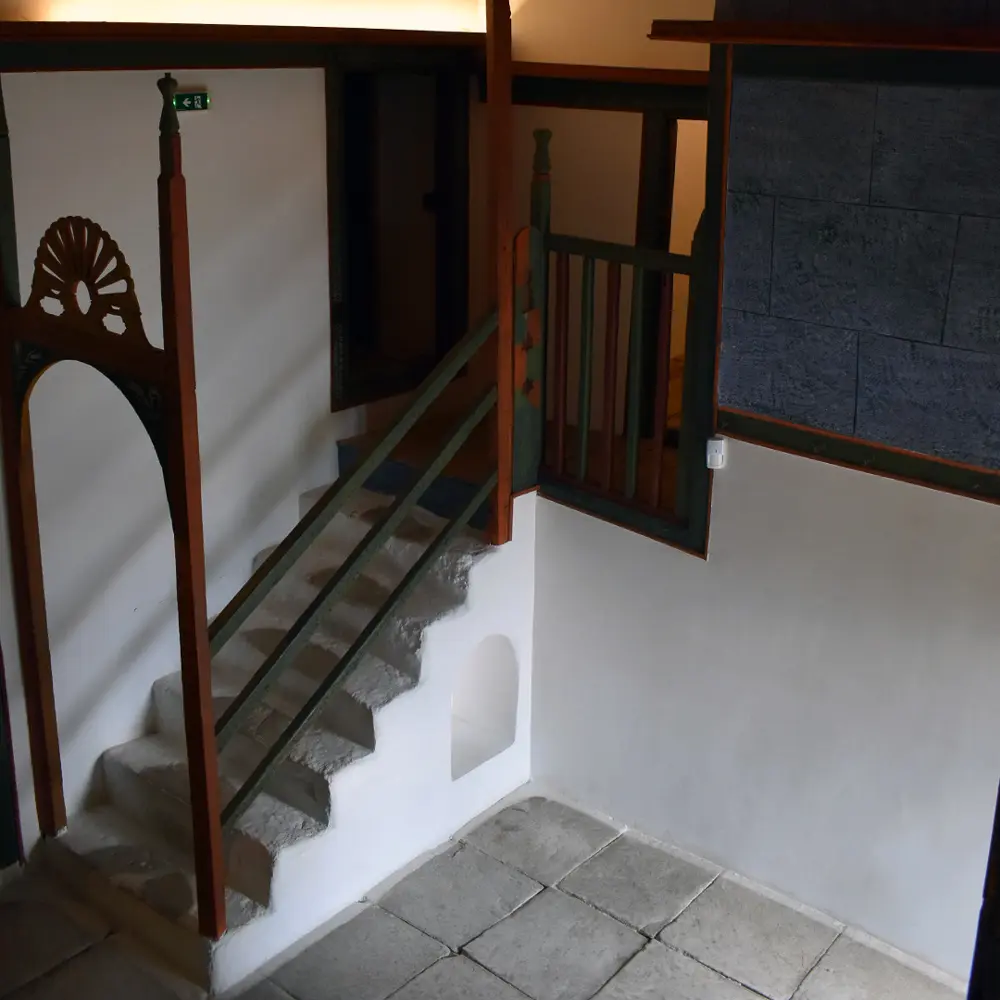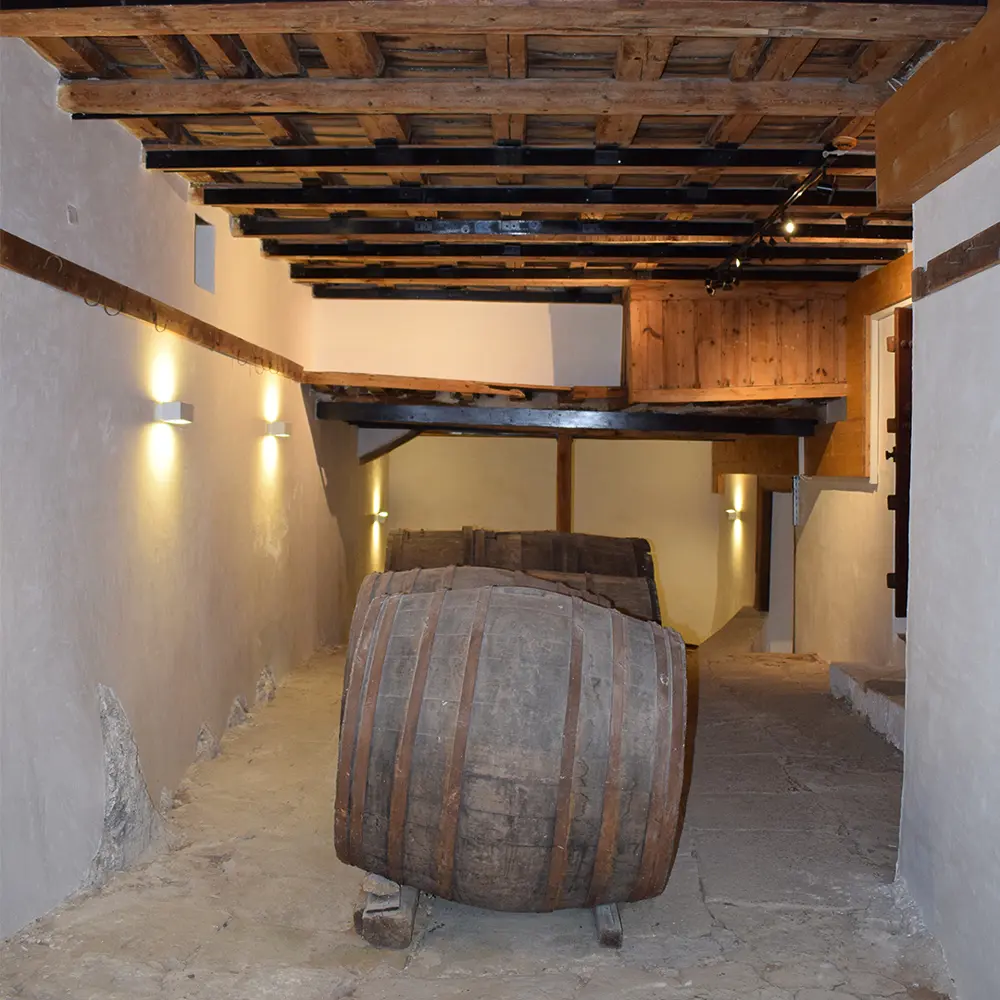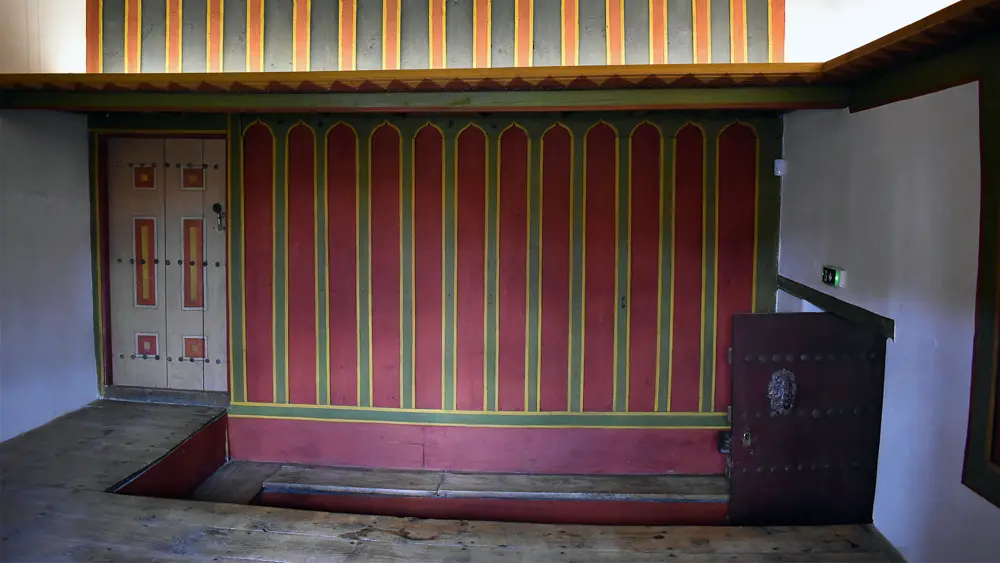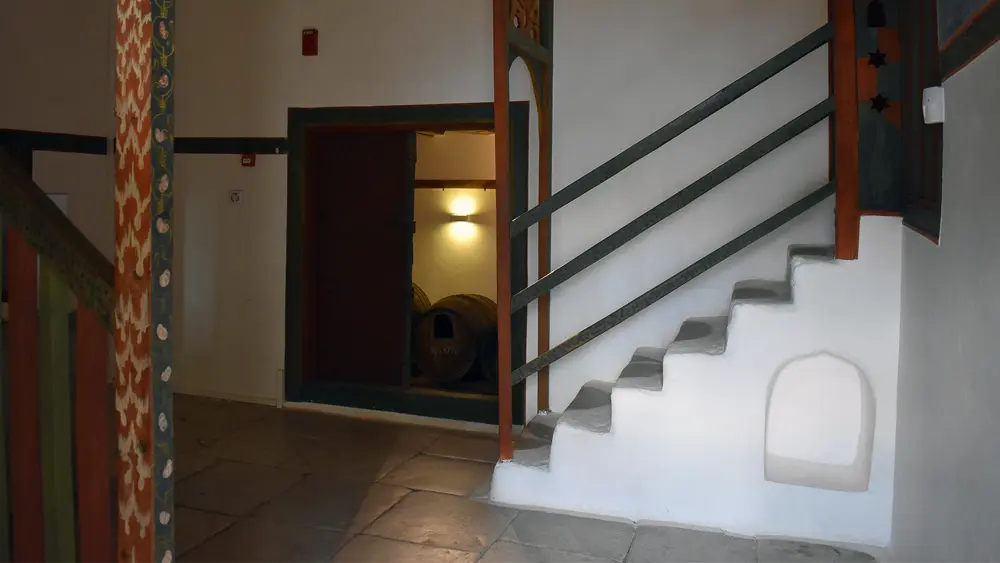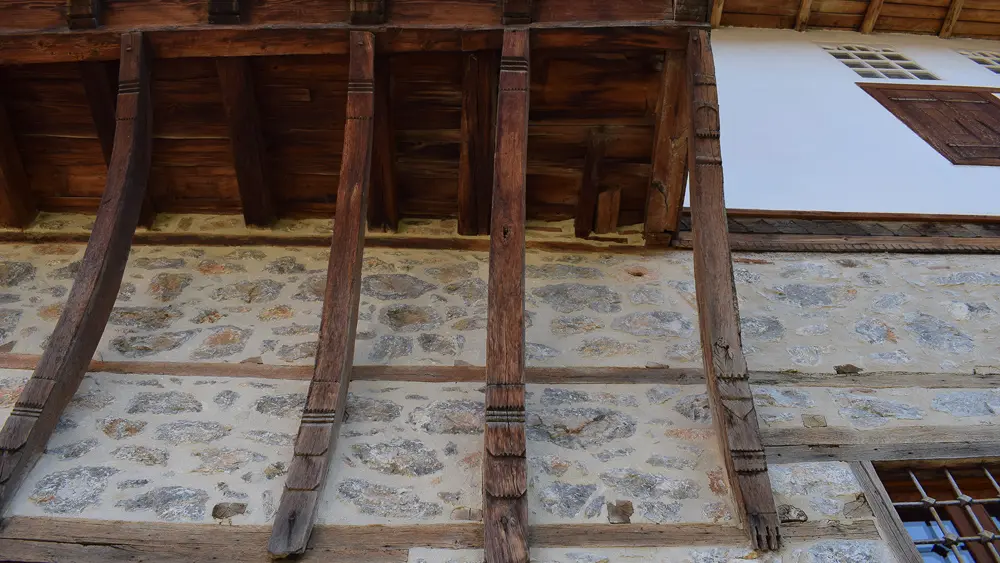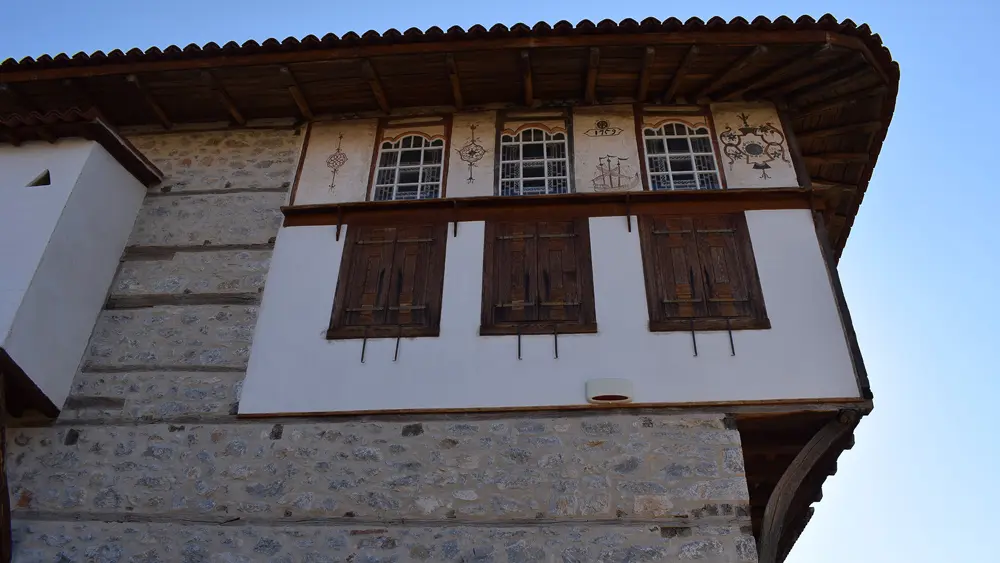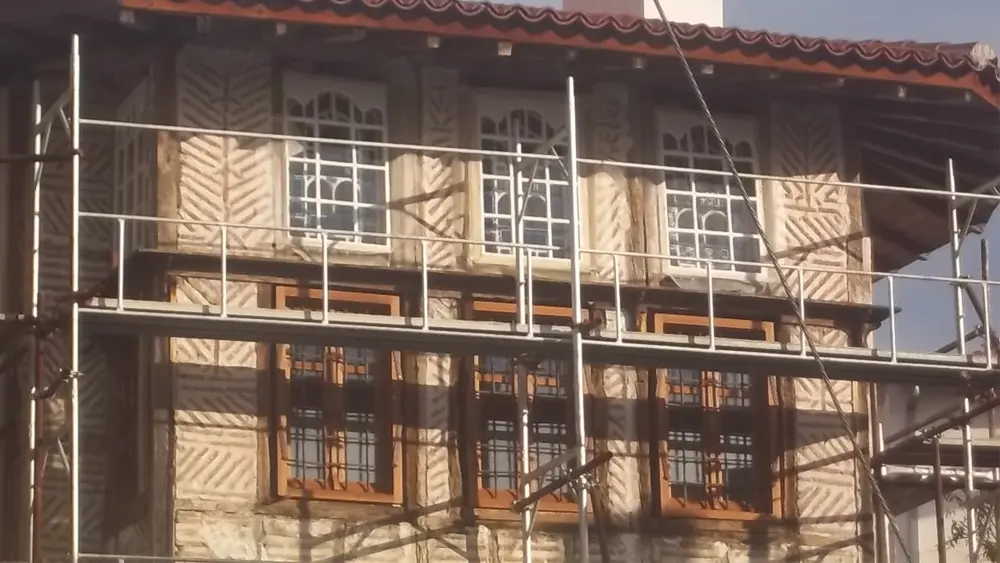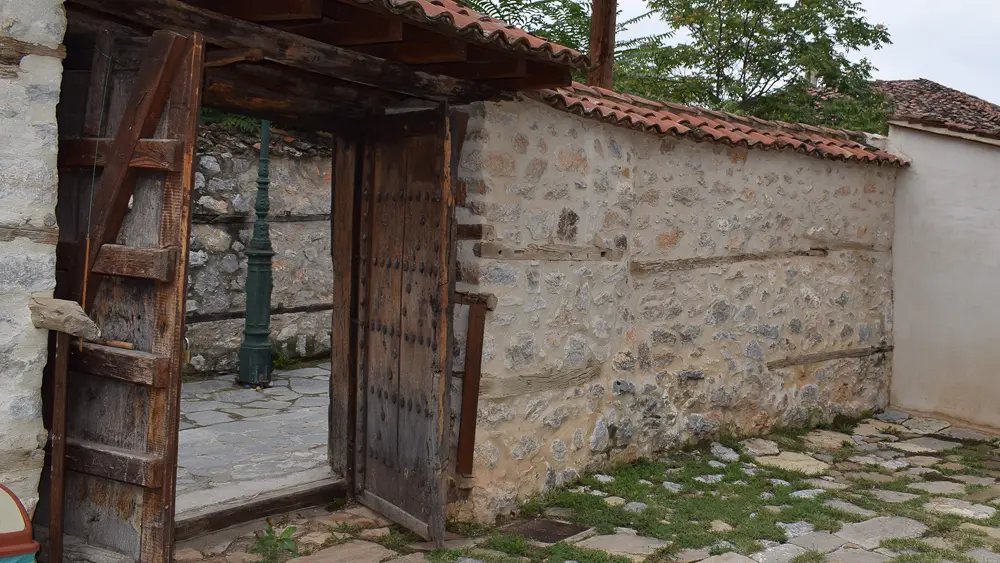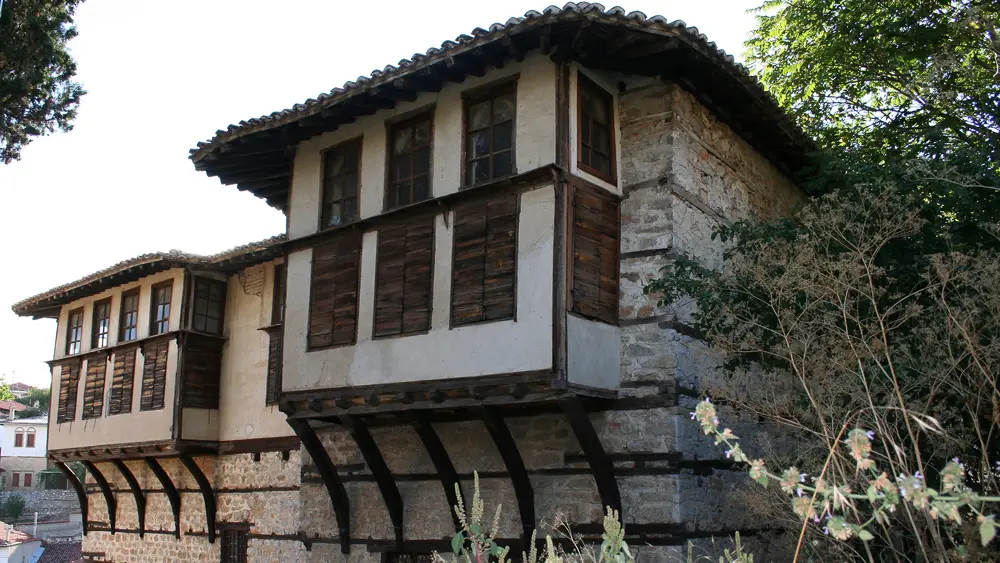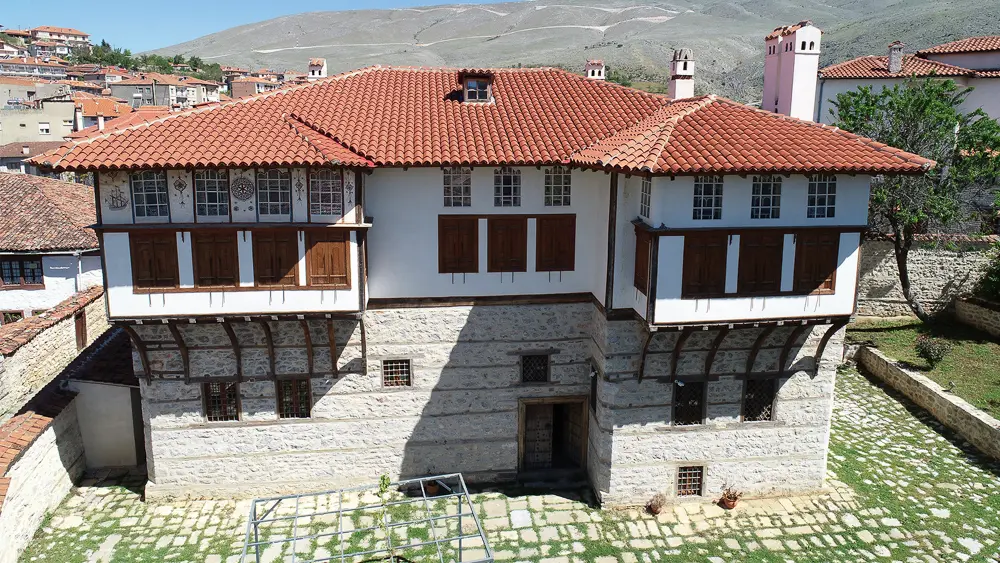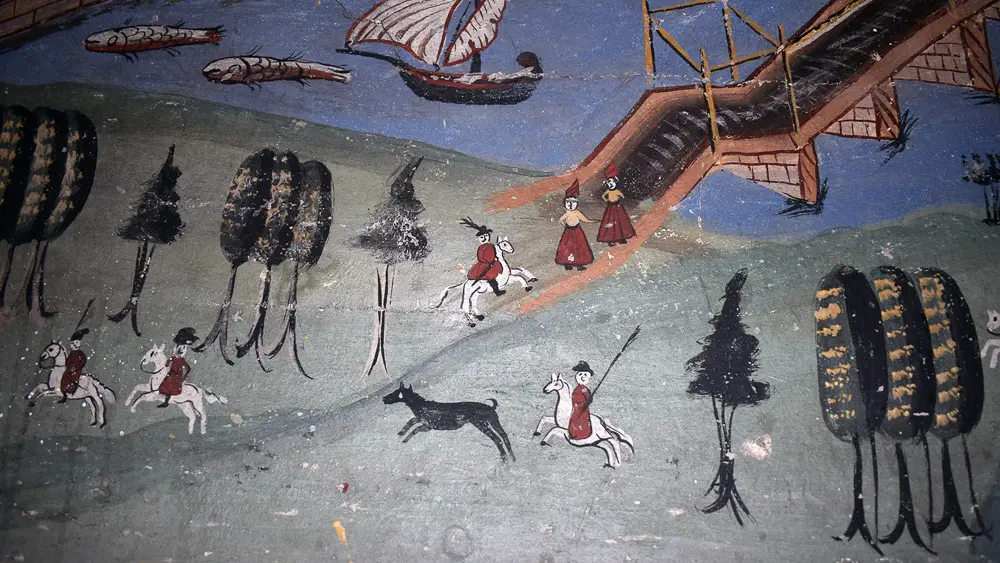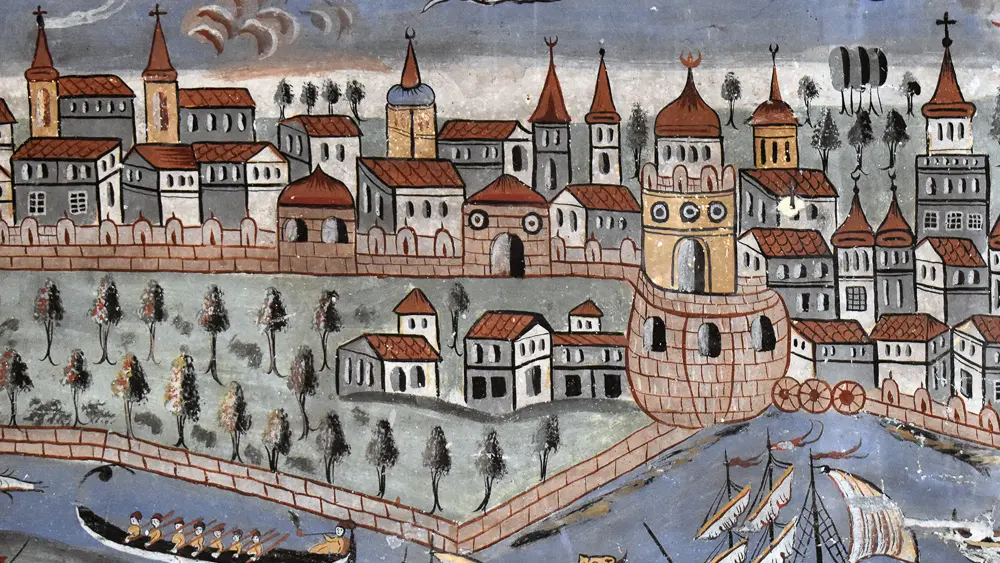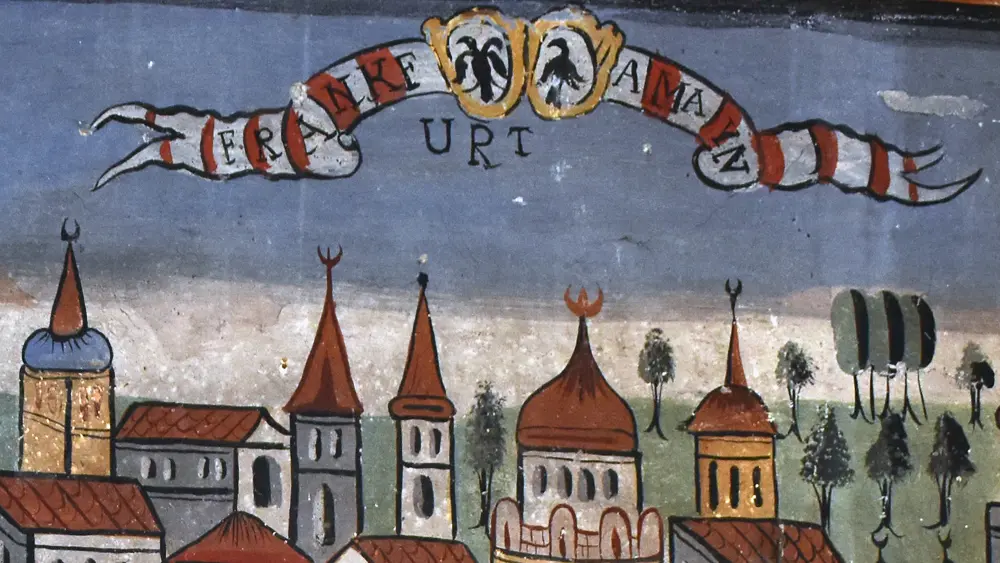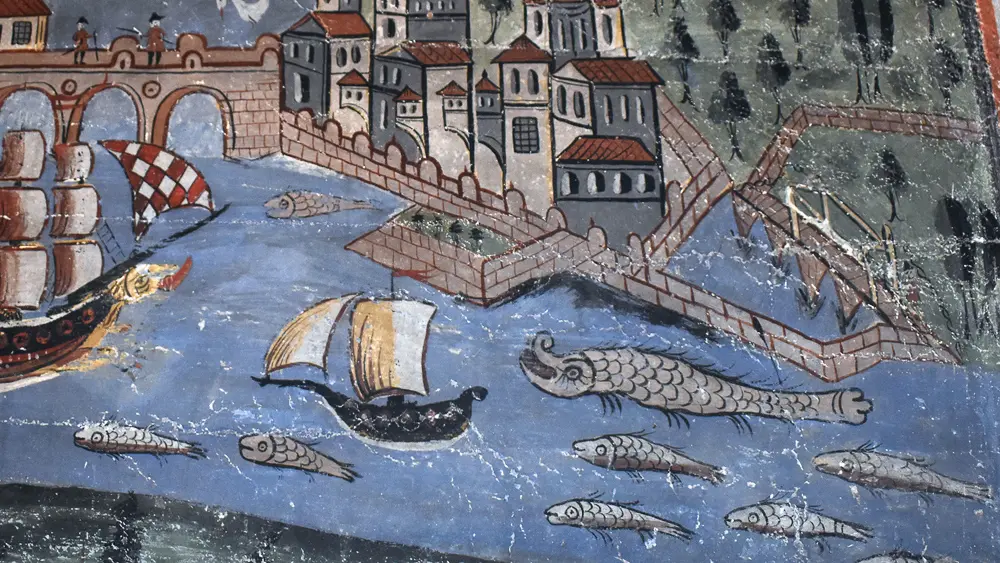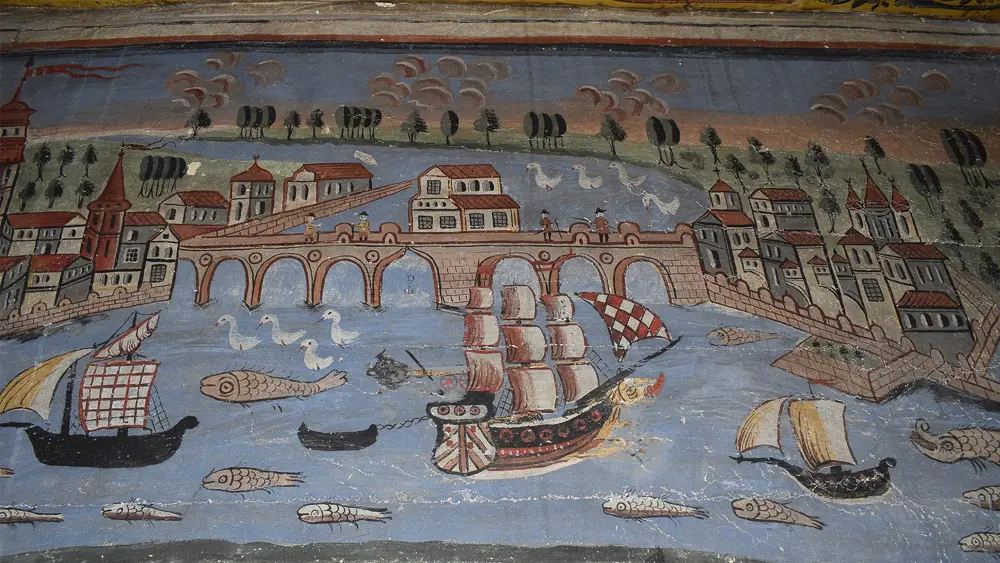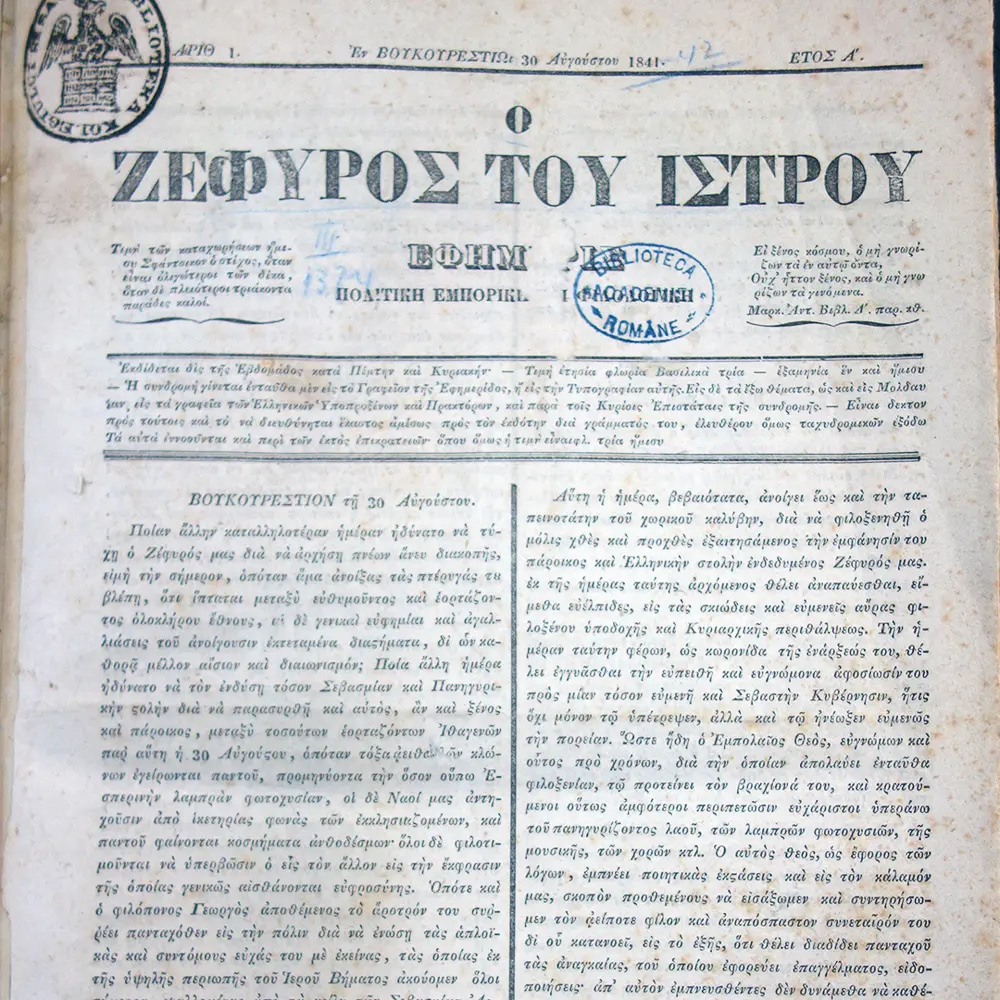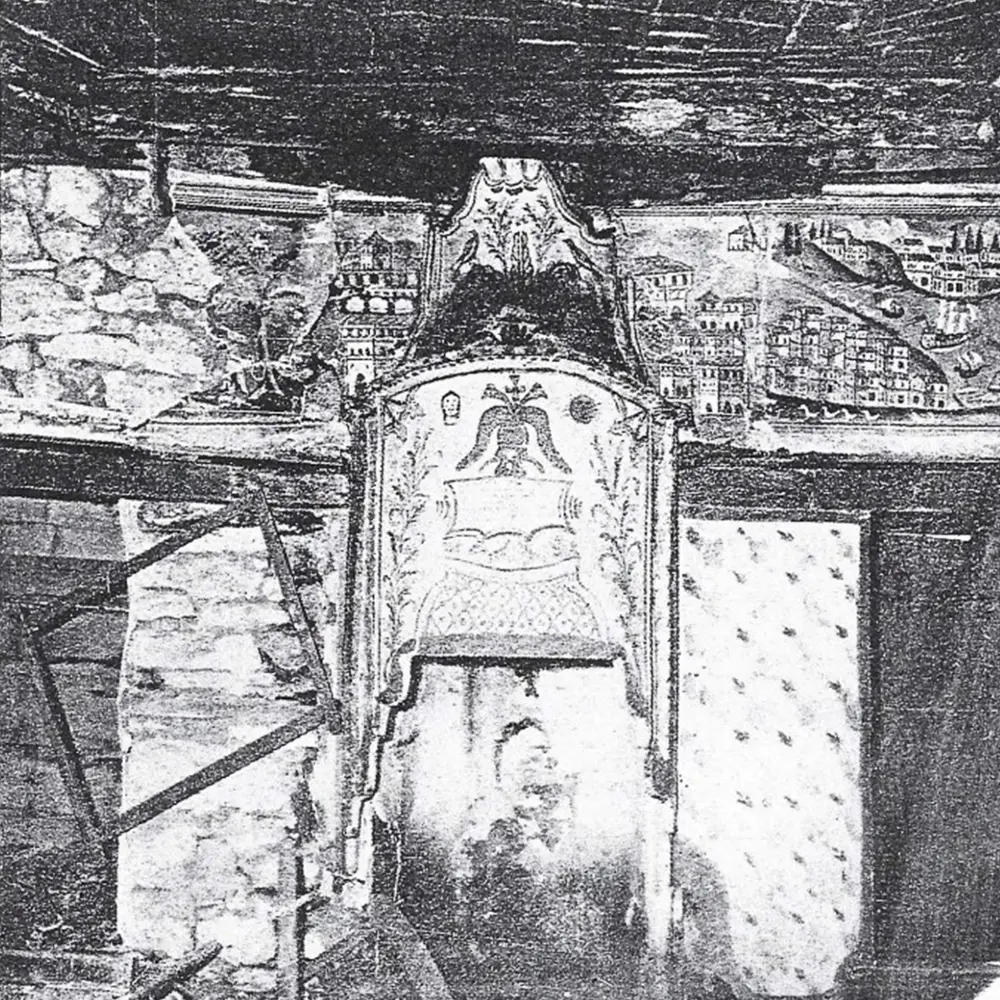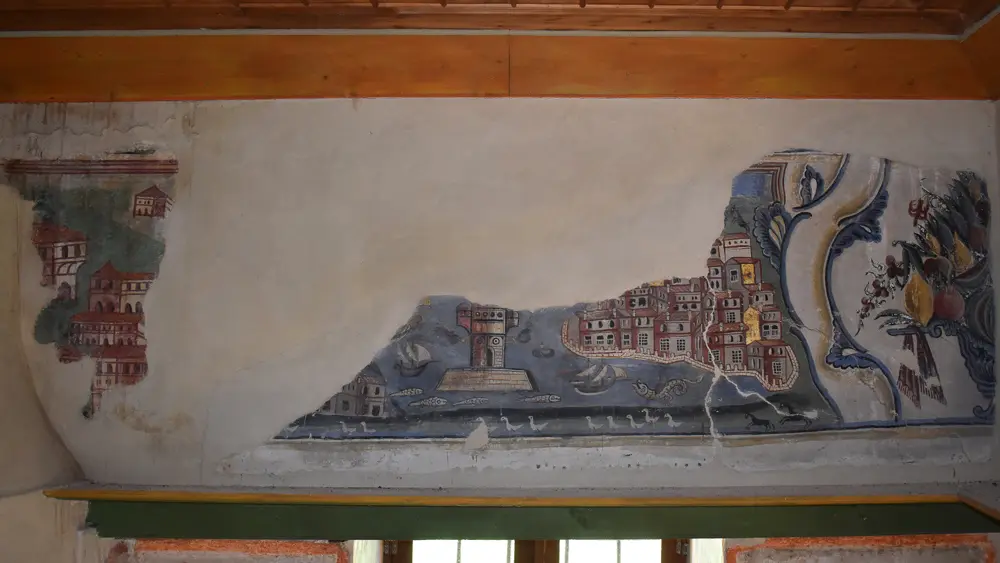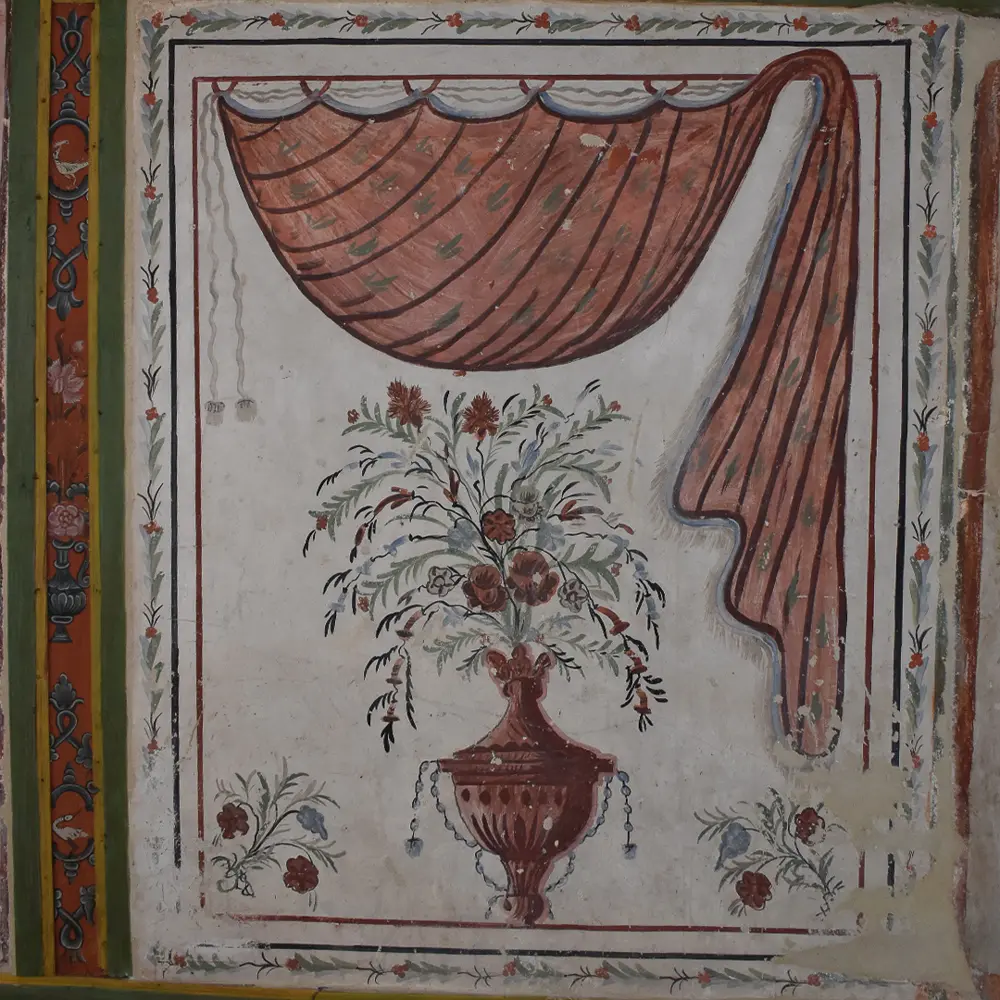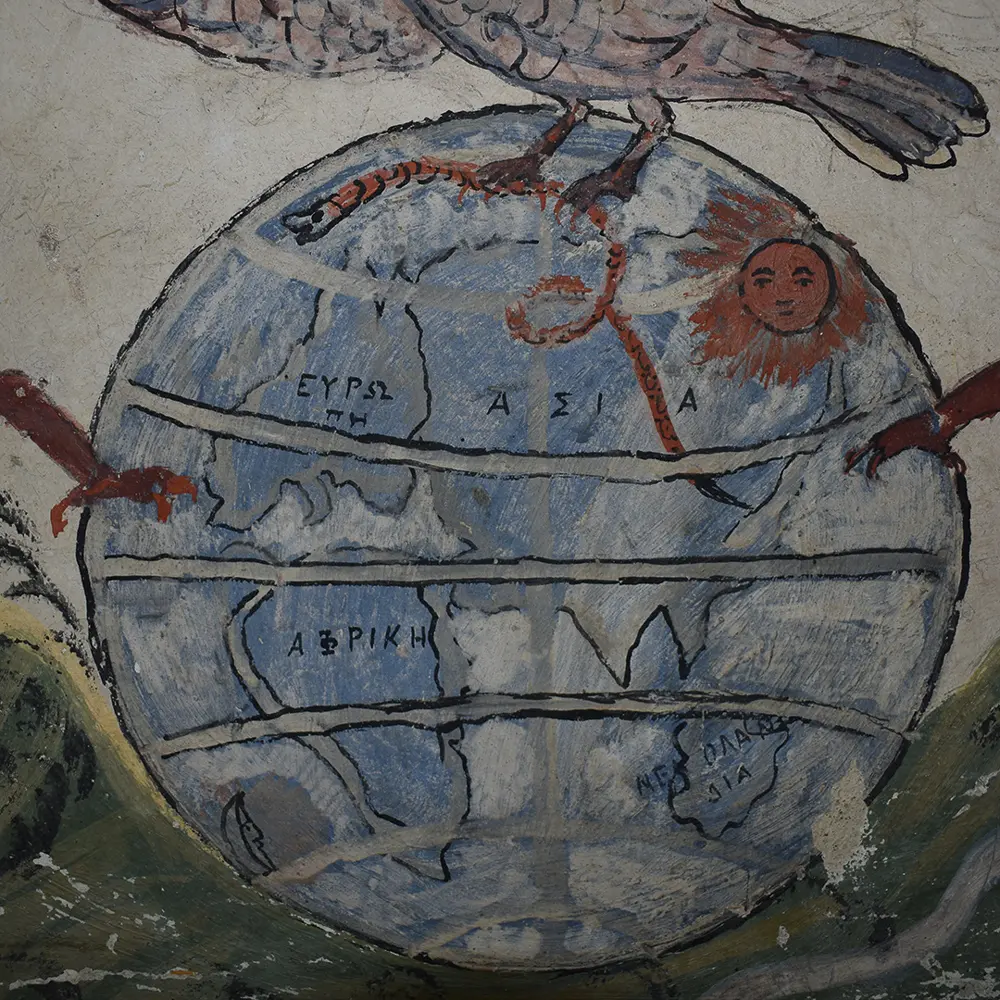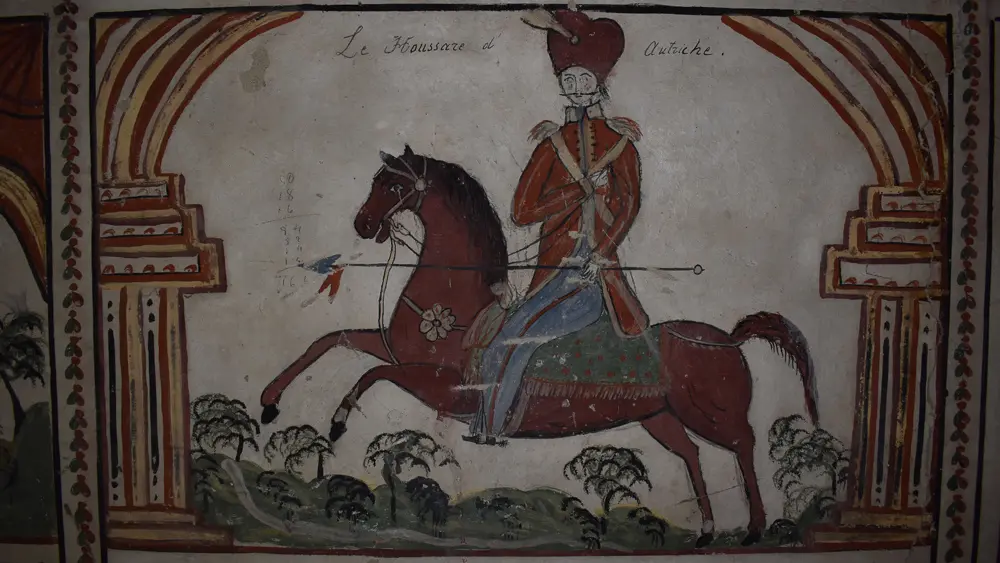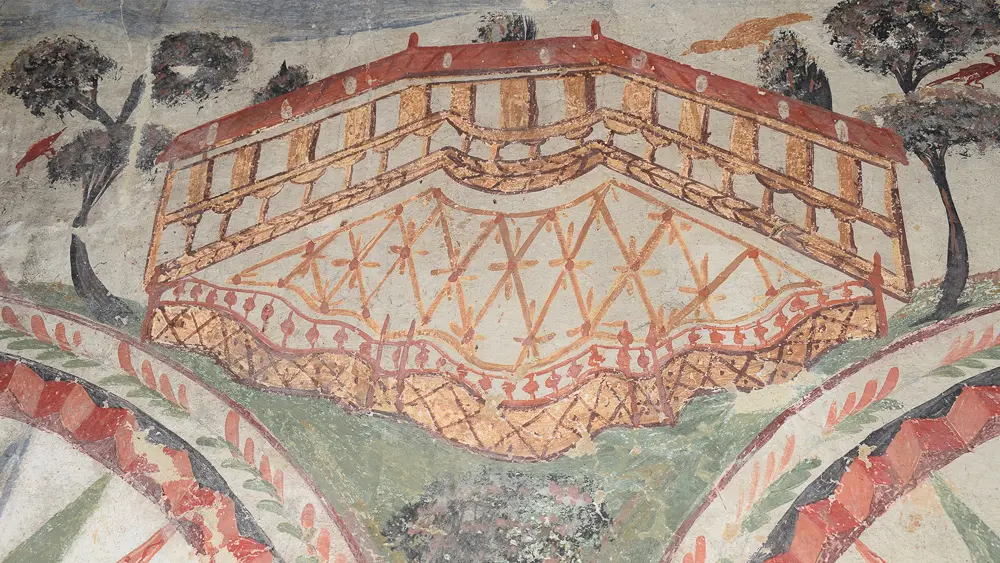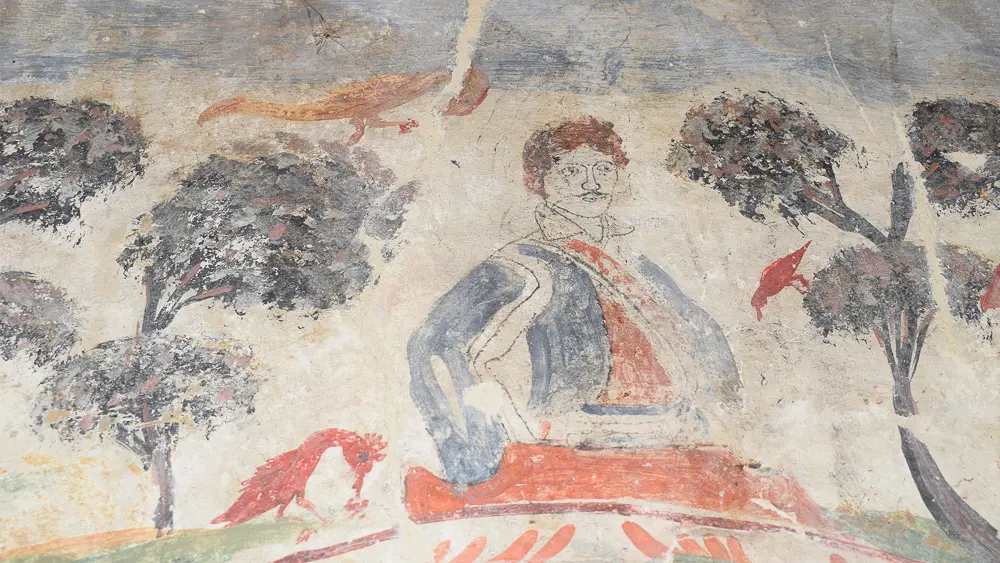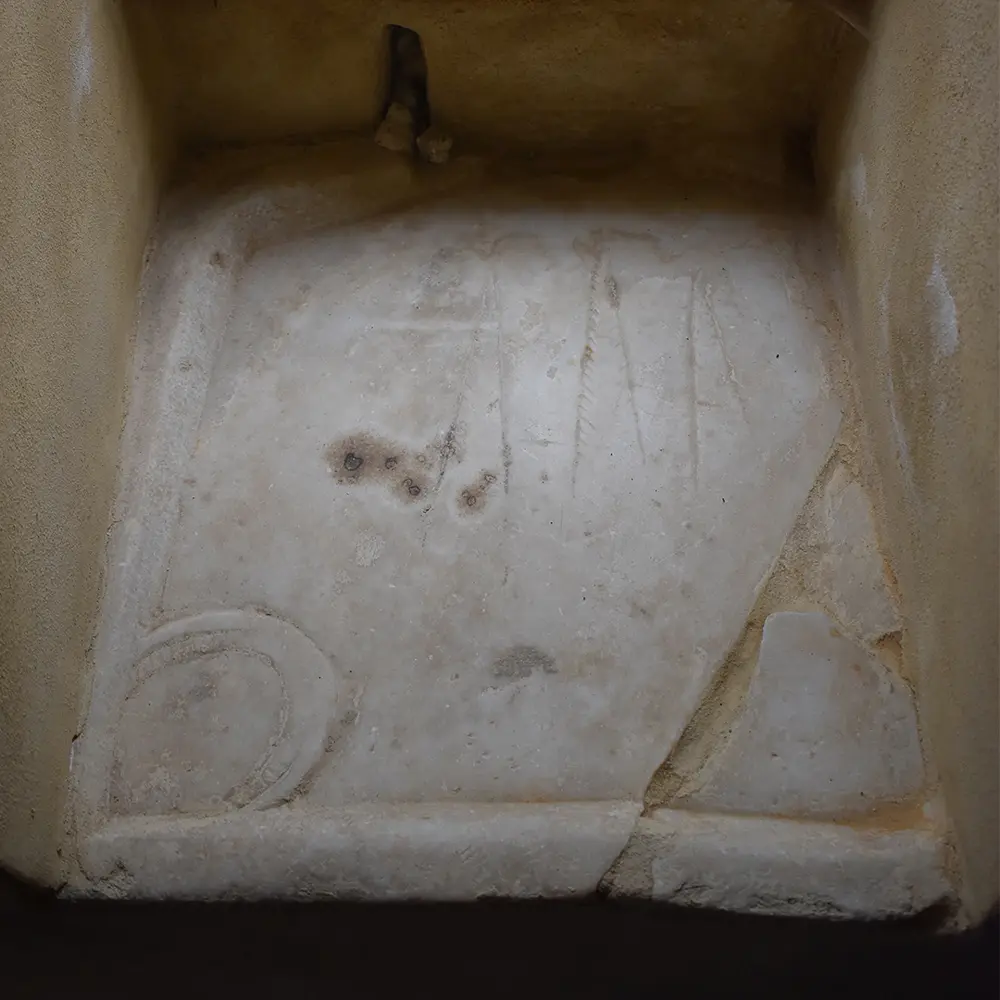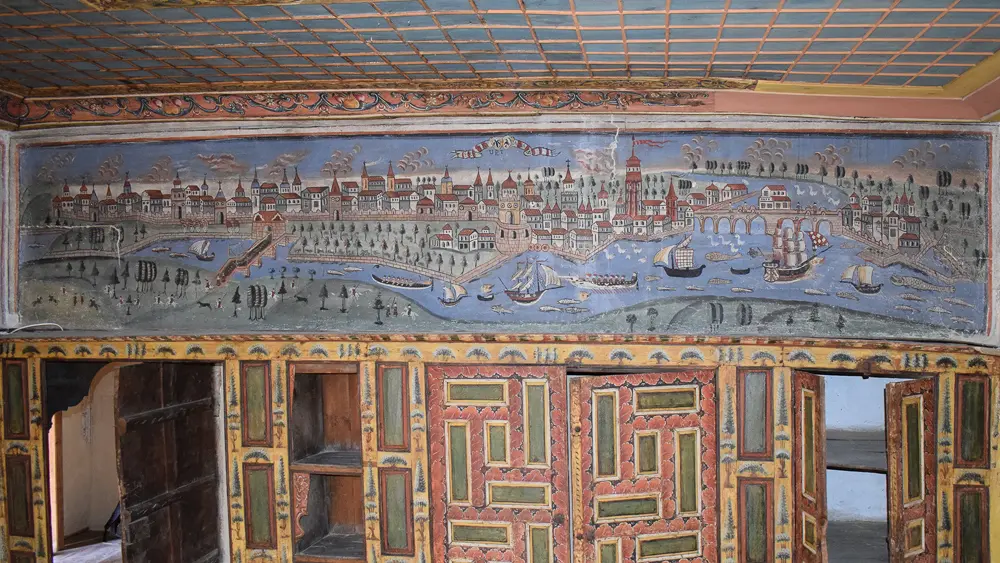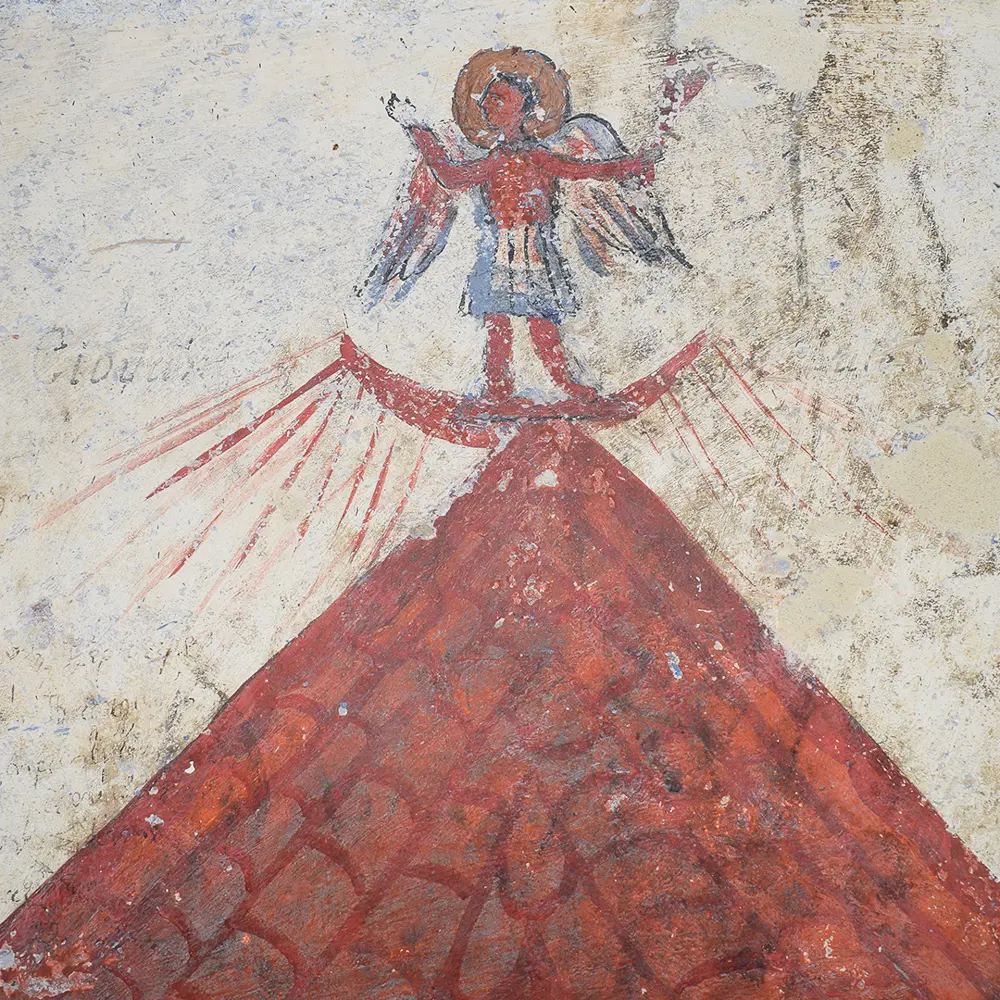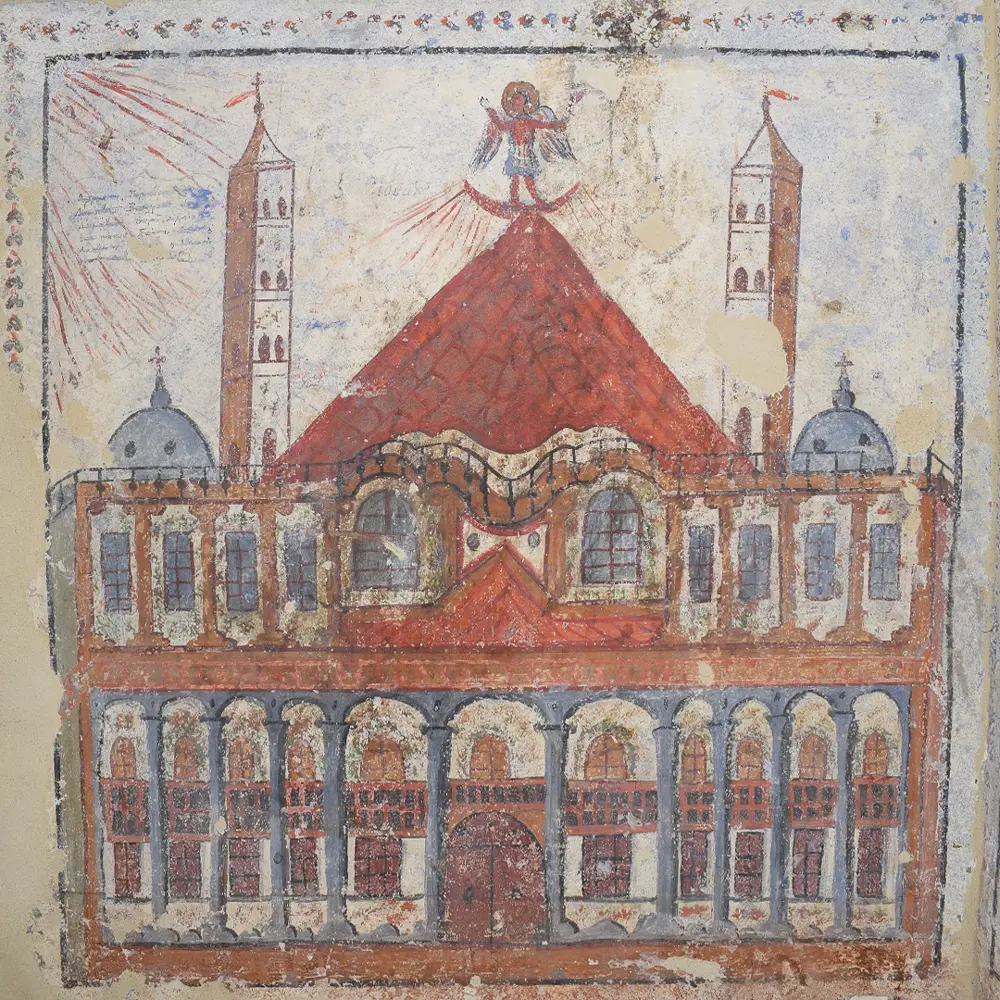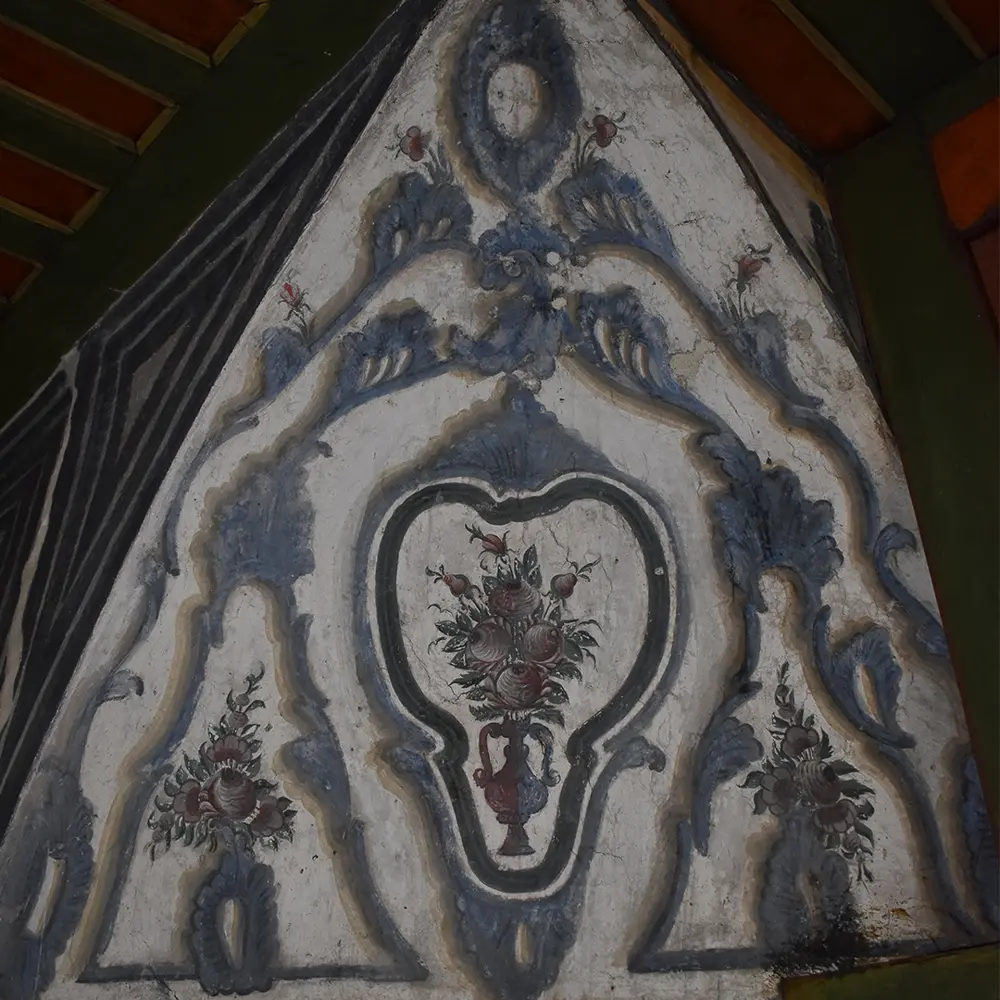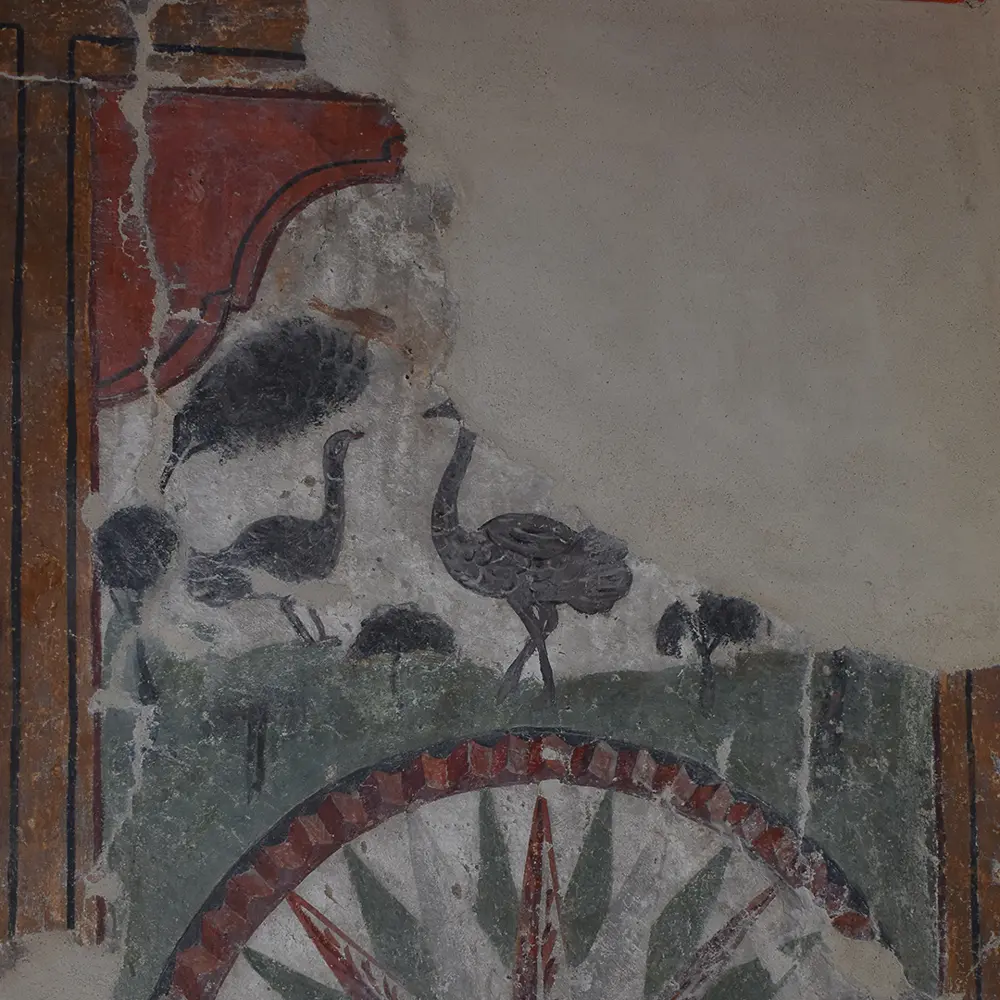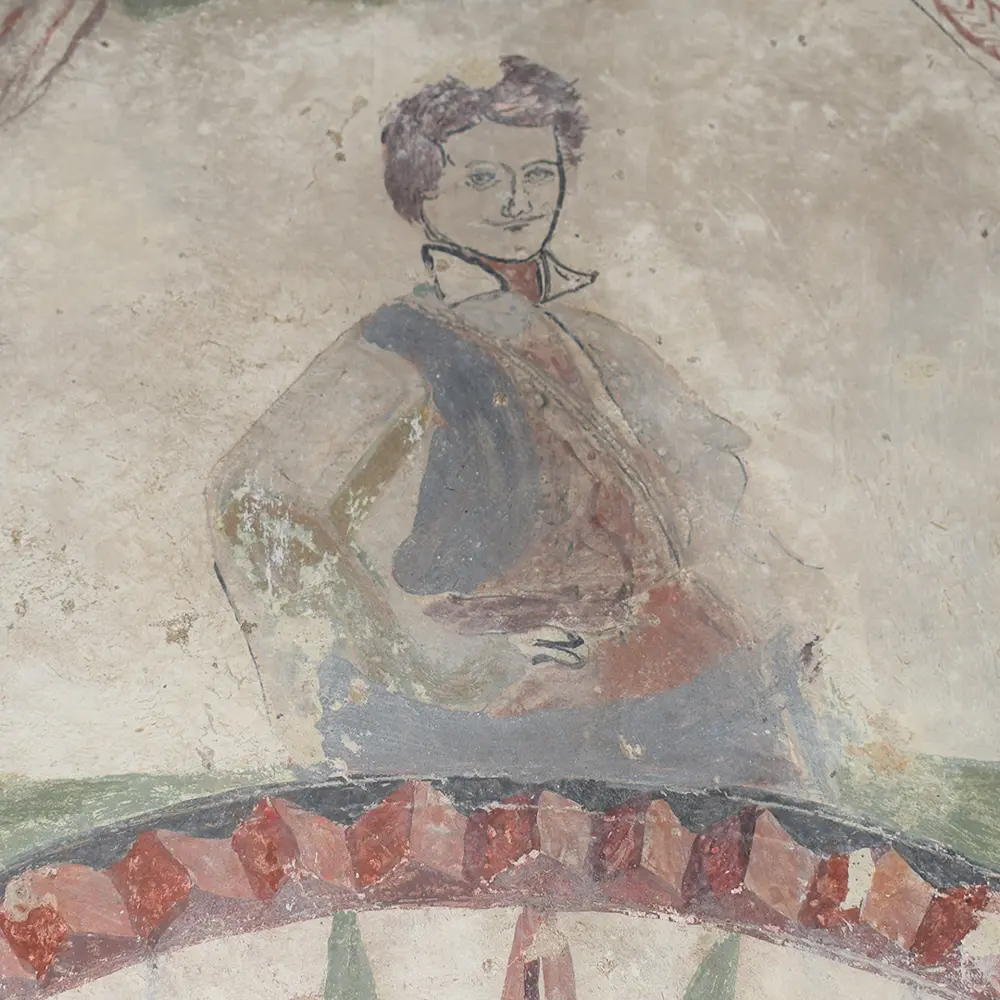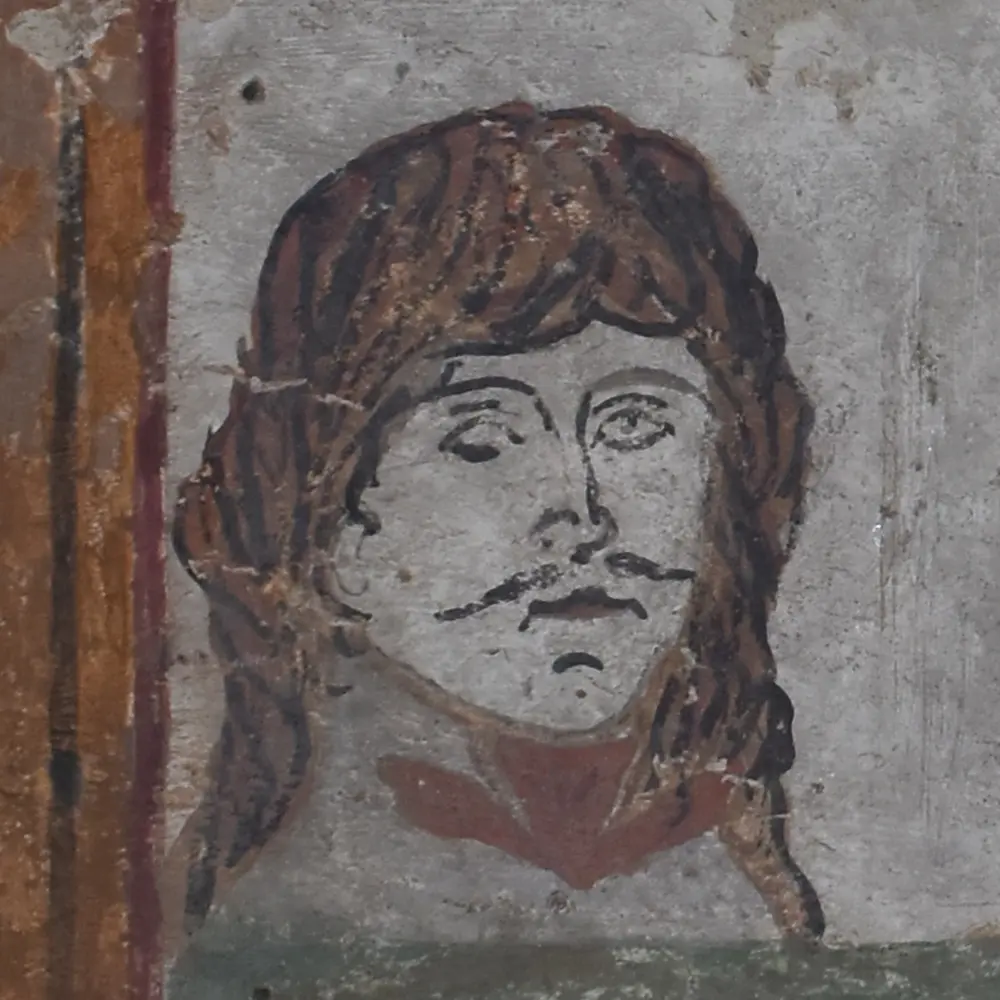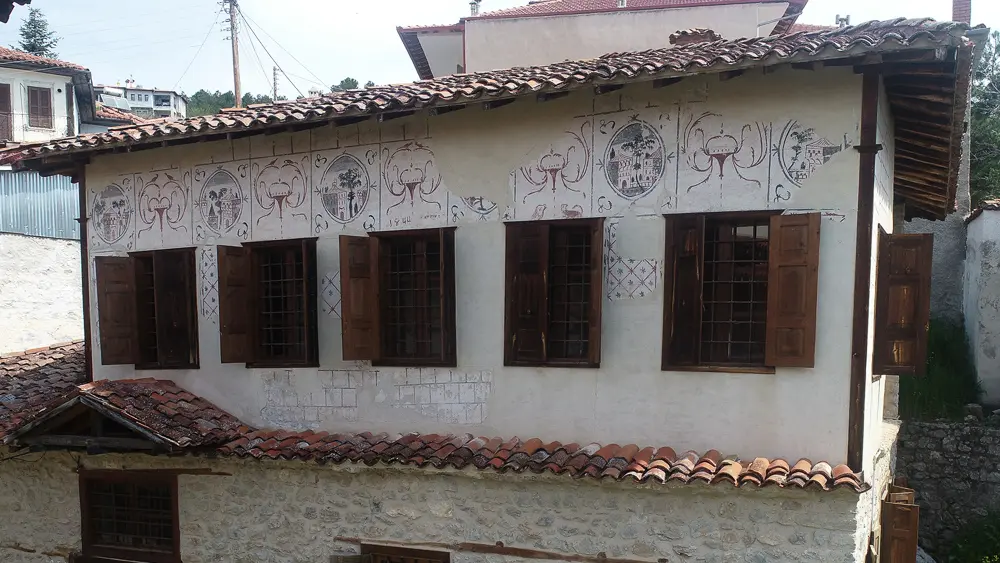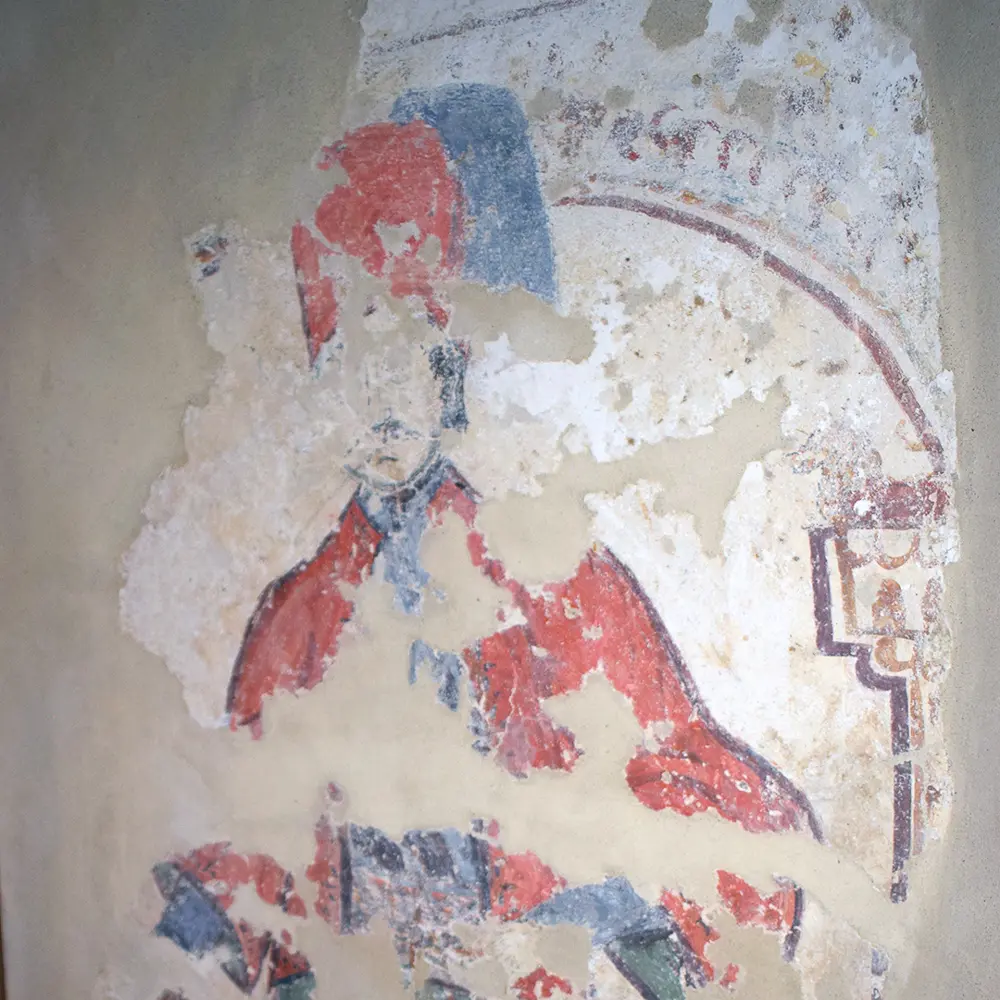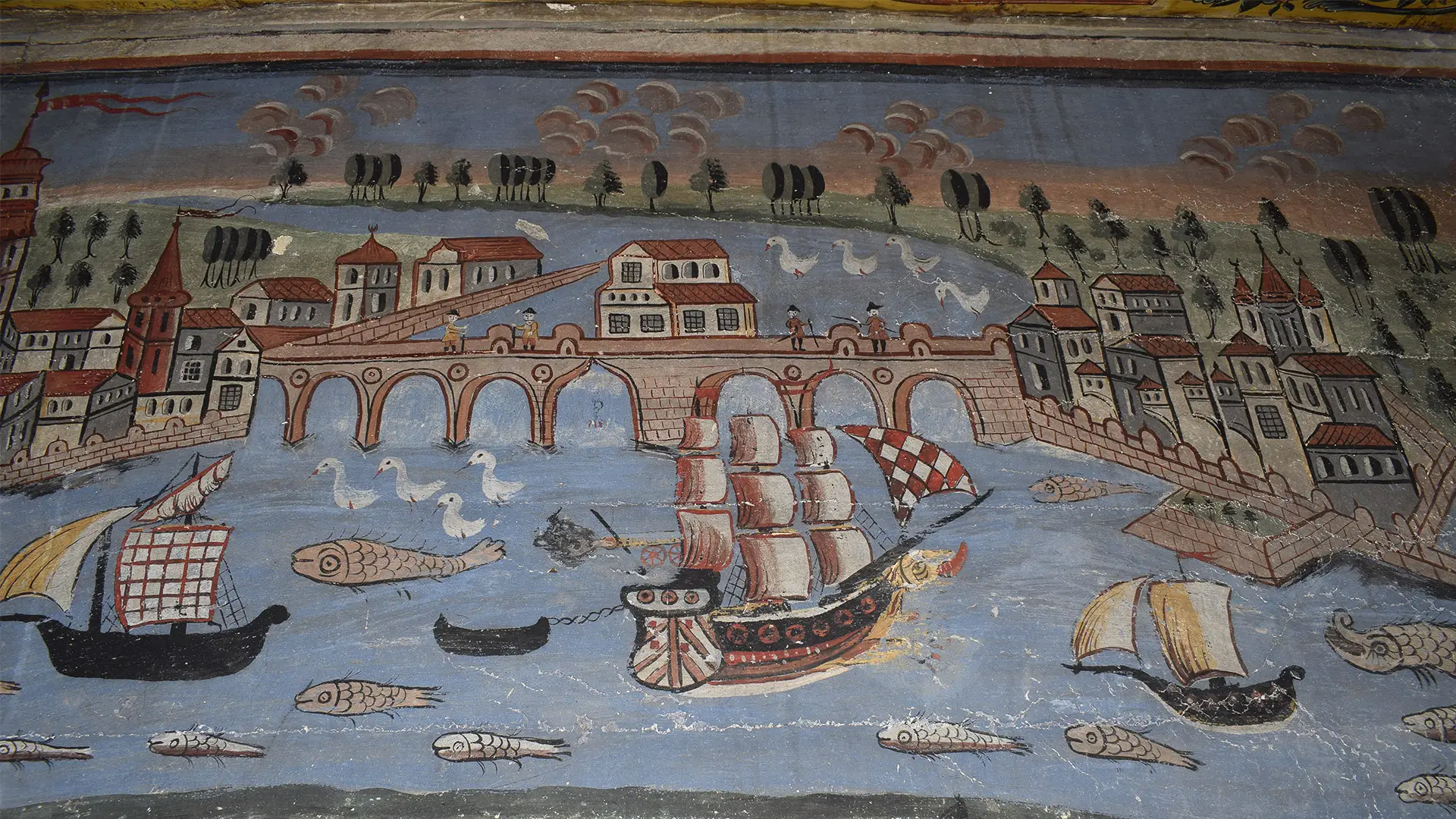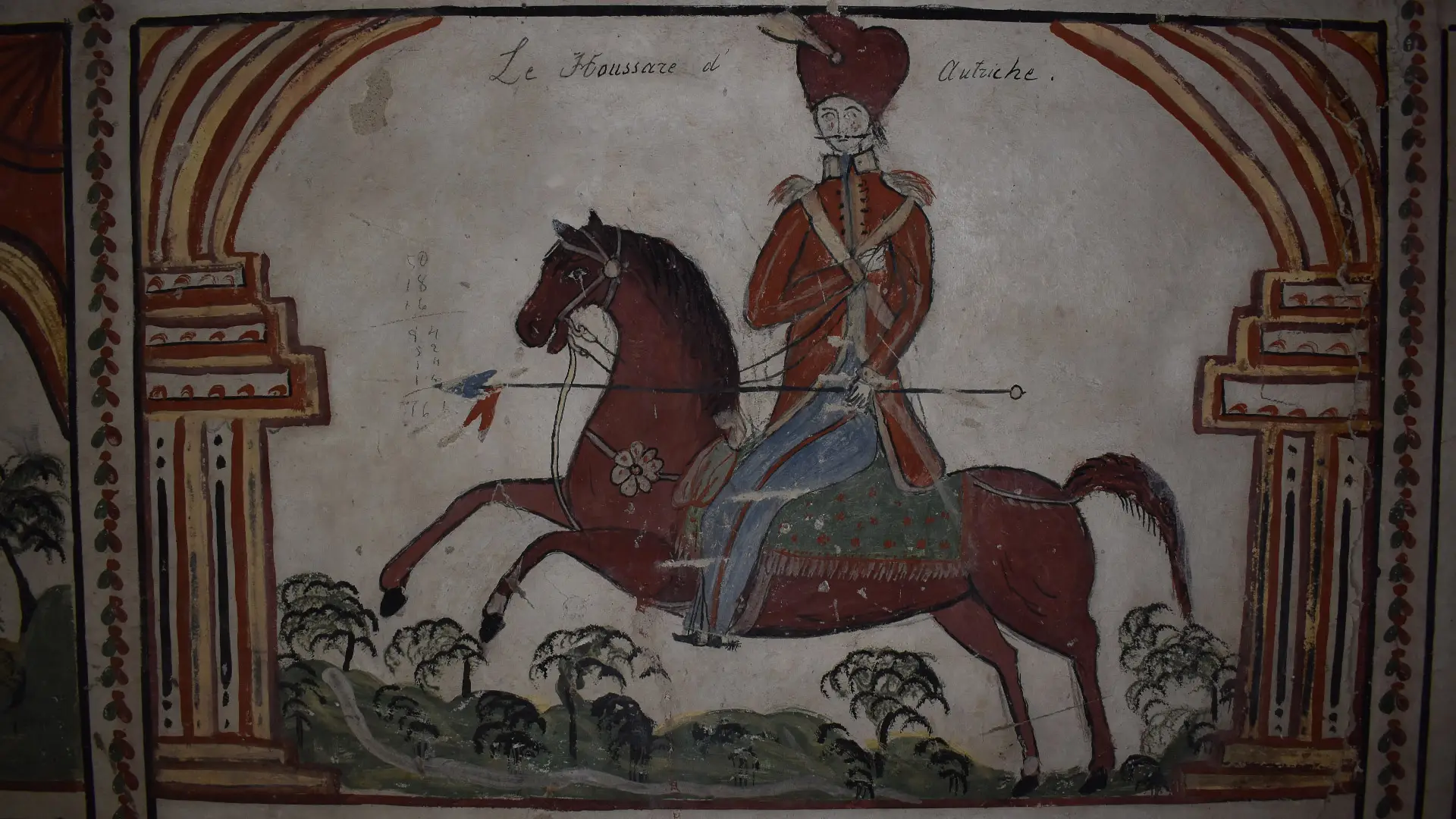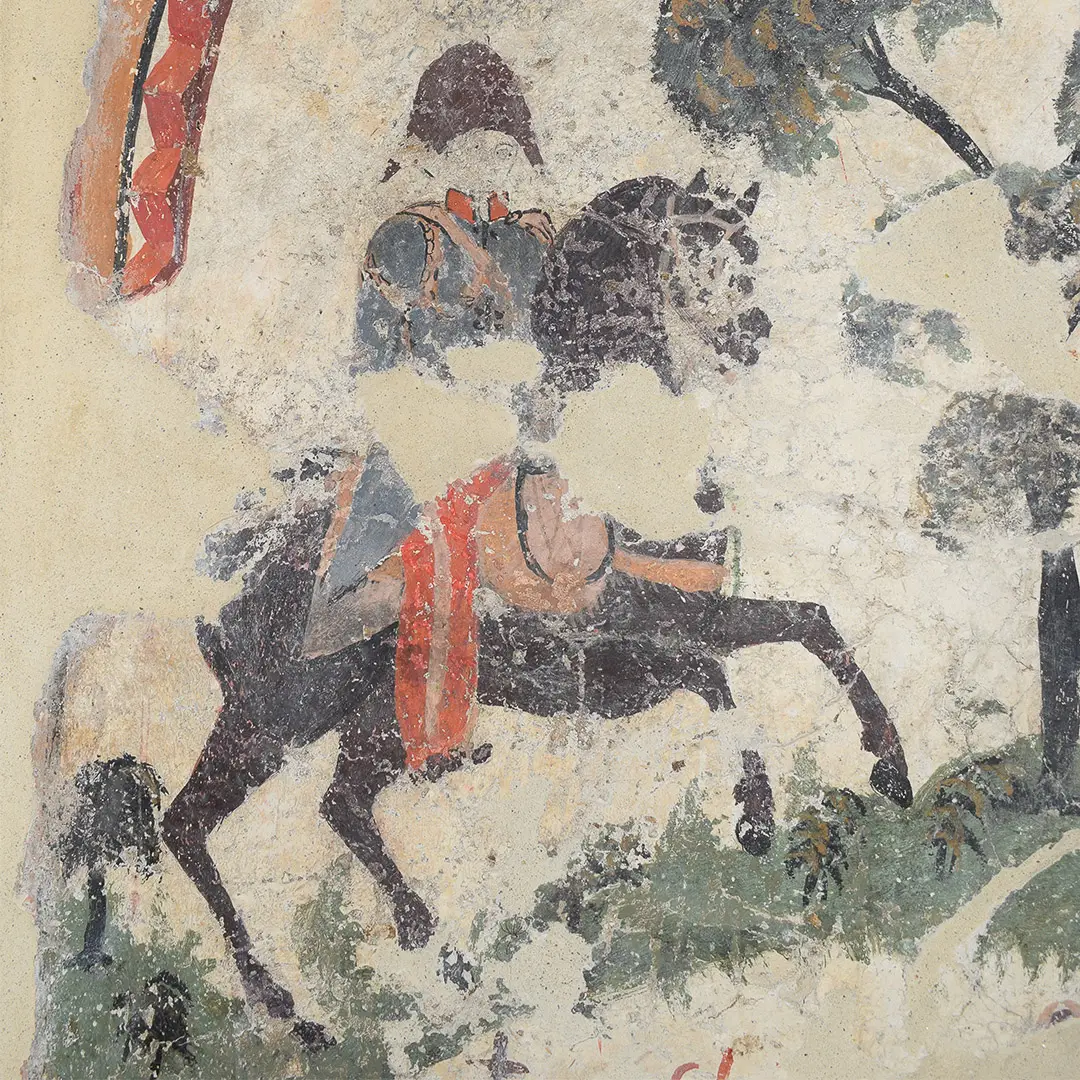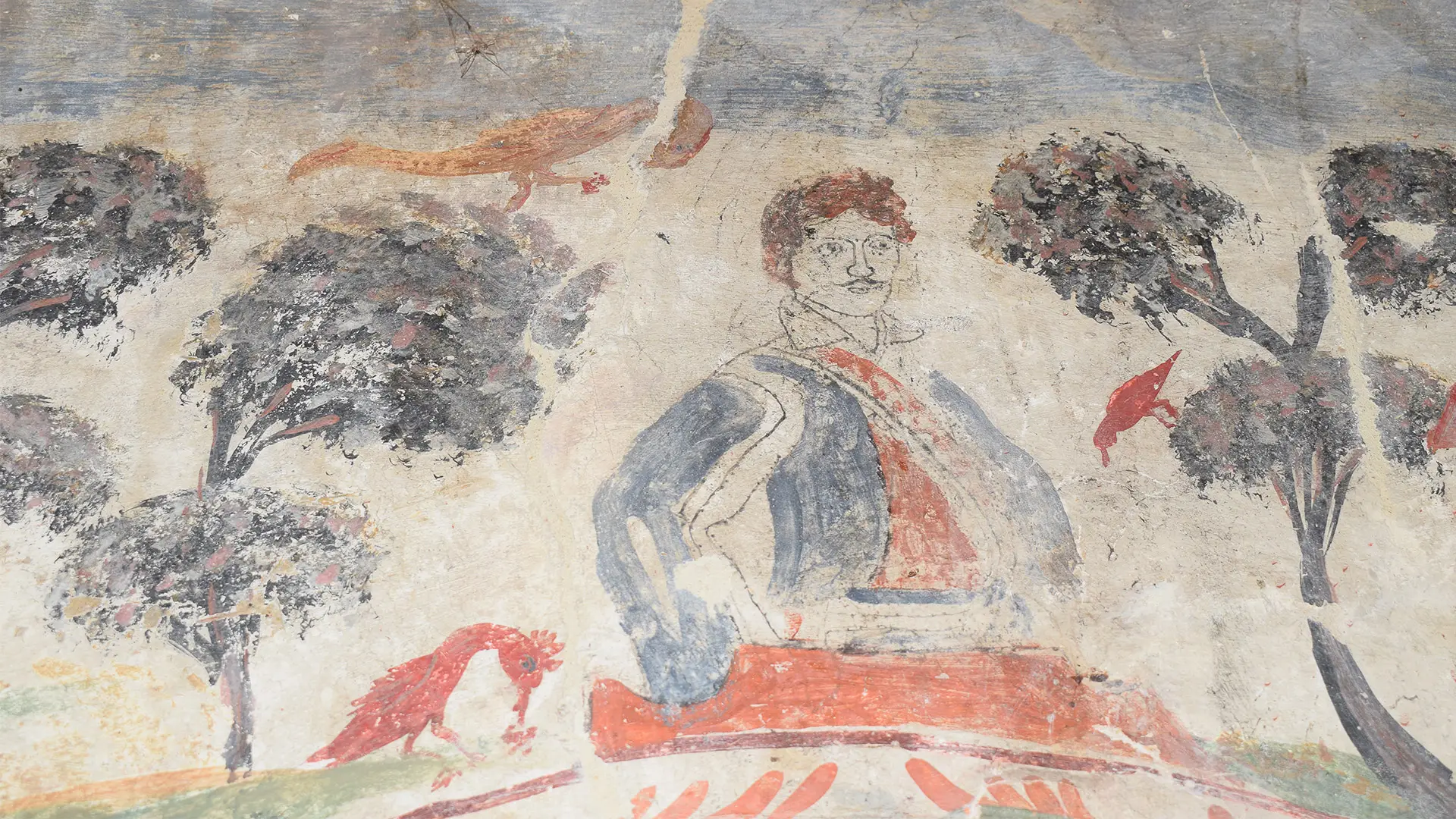The wealthy people of Siatista from abroad, apart from their charitable works towards their place, wanted to show off their wealth by building impressive mansions in Siatista. From the end of the 17th to the 19th century, experienced craftsmen built magnificent two-storey houses with a high courtyard that provided many comforts to their residents, while protecting them from external dangers and raids by intruders. The basic materials for the construction of the mansions, stone and wood, were sourced locally, but for their interior decoration they did not hesitate to place orders from abroad, as for example for the stained glass windows.
Around the main building of a mansion were the auxiliary quarters for daily tasks and for the care of animals, while later buildings were added for the accommodation of relatives, the so-called ‘musafirika’. A cistern and a well met the basic water needs of the residents.
The mansions were decorated by itinerant Balkan painters, who enriched their creations with drawings from etchings of the period, i.e. representations engraved on copper plates, or inspired by the narratives of the well-travelled Siatistians themselves.
Representations depicting Constantinople, Frankfurt, Madrid, are harmoniously combined with mythological scenes, Ottoman decorative motifs, representations of post-Byzantine art, Baroque, Rococo, and the folk art of the period.
The decoration of the mansions of Siatista is a special example of art and especially of the painting of that period. Built from the middle of the 18th century onwards, they are filled with rich decorative elements, precious materials and abundant wall paintings of particular beauty, all inspired by the life, images, impressions and experiences of the Siatistian bourgeois merchants in Europe, who, as owners of the mansions, wanted to show off their financial standing. The abundance of food, their material goods and even everyday objects are depicted on the walls and in the festive rooms where they welcomed their guests. Thus, the walls of mansions became the space on which painters could freely unfold their imagination.
Among the subjects masterfully painted by the painters on the murals of the mansions of Siatista we find:
Colors, symmetry, decorative and floral patterns, these are the dominant elements in this type of painting. The forms are simple and stylized. Perspective is present in many paintings, yet not depicted in a typical manner. What is important, is the educational character of the artworks. To achieve this, the painters use narrative scenes and naturalistic depiction. At the same time, heroism and myths ignite artistic imagination giving the artworks a poetic touch. It is a type of art that is created within everyday life, recording and describing all the social, historical and political conditions of that time. Furthermore, these paintings are conducted in a period, when lots of people are illiterate, and thus the artworks are constructed through simple images and symbols, so that they can be easily understood by everyone.
The painters who decorated these mansions, had already mastered the art and tradition of religious Byzantine painting, and were directly influenced by it. In fact, many of them were icon painters and had apprenticed in traditional Byzantine painting workshops. Historical and social developments, however, led them to further enrich their imagery with the introduction of new artistic styles. The fact that the Greeks were under the Ottoman rule, along with Greece’s geographical position and commercial contacts with European countries, had a lot of influence over the decoration of the mansions in Siatista. Artists started incorporating elements originating from both, Islamic Art (especially Persian and Ottoman art), as well as from Western European artistic styles, such as Baroque and Rococo. The art of the East generally included geometrical and floral representations, mainly polychrome, linear and symmetrical, as well as delicate lacelike decorations, the so-called arabesques. Baroque and Rococo evolved during the 17th and 18th centuries, mainly in Italy and France, but gradually spread around many other countries in Europe. They involved many art forms and used rich and bold decoration. Baroque was created to impress whereas Rococo to please the audience. The rich merchants from Siatista, who were keen admirers of these styles, had their mansions decorated with the use of Baroque and Rococo motifs. All of the above features can be found blended in paintings and decorations at the mansions of Siatista, creating a new form of art which is broad and multifarious.
The mansions in Siatista were designed, built and decorated by engineers, craftsmen and artists coming from Macedonia and Epirus. Several inscriptions, which were found in the mansions, inform us that craftsmen and artists from Konitsa and other villages in Epirus worked in the city of Siatista. Such villages were located in Grammos, Tzoumerka, Pindos and Voio areas. They are known as “Craftsmen Villages” (Greek term: Mastorochoria), because they were traditionally inhabited by professional builders or craftsmen and their families. Craftsmen left from their villages every year and started their journey all around Greece, moving from place to place, in order to build and decorate their commissioners’ mansions. They were organized in groups of approximately 20 people, which were called guilds and they were led by the master craftsman. The groups consisted of builders, painters, marble sculptors, carpenters, glaziers etc. The painters who decorated the mansions were either permanent members of a guild or wandering artists and only few of their names are known to us. Their work is classified as anonymous post-Byzantine and folk art, due to the fact that painting was considered to express an overall aesthetic rather than the inspiration and skills of an individual.
The artists used various painting techniques and materials. Their palette included colors such as red, yellow, ocher, dark blue, light blue, green and many other colors carefully chosen, combined in harmony, making the wall paintings more imposing. The colors were handmade with the use of flowers, herbs or minerals, mixed with water, oil or egg, in order to spread evenly and be more stable.
The walls were decorated with fresco paintings. The artists, painted the murals directly on plaster while it was still fresh. First, they worked the background and then completed the decoration of the entire surface and painted the details. Wooden surfaces were directly painted with a free hand and confident, quick strokes, while the relief decorations on the walls were created using plaster.
The interior decoration of the mansions of Siatista in the 18th and 19th centuries is complemented by carvings in marble or wood, plaster frames, but also by skylights, enriched with decorative motifs and dressed with colored glass. As with other forms of folk art of the Post-Byzantine period, these types of decoration can be found in both religious and secular architecture.
During the Post-Byzantine period, three-dimensional sculptures are rare and eventually get replaced by decorative reliefs. These reliefs adorn fountains and belfries in towns and villages, as well as tombs at the cemeteries, they also frame the doors, windows and skylights in houses and temples, or they are placed inside the buildings to enrich their decoration. In the mansions of Siatista they are found in various parts of the courtyard and the house. On fountains, arbours, inscriptions, fireplaces, sinks and elsewhere. The designs carved by the stone carvers on marble and stone were similar to the designs on other popular creations of the period, namely embroidery, paintings and woodcarvings. Like painting, the sculptures are characterised by spontaneity, simplicity, love of nature and tell their own stories. They are influenced by Byzantine and oriental traditions, beliefs and customs of the locals. They include countless symbols such as crosses, two-headed eagles, saints, human figures, suns, dragons, snakes and flowers. Their purpose was to protect people from spirits and the evil eye, and to drive demons away from the house.
The sculptors belonged to the groups of craftsmen who built and decorated the mansions and traveled together from place to place. They were mainly artisans from Epirus and Macedonia. The marble for their work was either extracted from nearby mines, or taken from older monuments in second-use.
Woodcarving is another art that flourished at that time throughout Greece. Woodcarvings are found in altarpieces, pulpits, chantries and various religious objects in churches and monasteries. The crooks and the flutes used by the shepherds in their everyday life as well as the ships along with their decorative elements, all of them are wood-carved. Last but not least, all the traditional houses and mansions are embellished with wooden elements, which testify the economic and social progress of the upper-class merchants from Siatista during the 18th and 19th centuries.
Carved decorations in the mansions at Siatista include ceilings with elaborate centerpieces, room dividers, gates and doors, closets, cupboards, shelves, icon stands, chests, seats etc.
The bright-colored shapes of the wood carvings, especially the intricate geometric-patterned ceilings, were all influenced by Eastern and Ottoman art. The preparation and processing of the woods were quite demanding and time-consuming procedures, that were committed with patience and hard work. When the woods were ready for use, they were carved by skilled carpenters who were usually members of the craftsmen’s guilds.
The architectural decoration at the mansions was completed with the use of rows of colorful stained glass skylights, placed on the second floor, between the regular windows and the roof. These wall openings, consisting of relief perforated shapes and frames made of plaster, were sealed with colored glasses making the house bright and colorful. The skylights were usually decorated with suns, triangles, circles and rhombuses, plants, trees and birds. Their construction was complex and difficult, and thus required a lot of experience. The style of the skylights was influenced by the European Baroque, which gave great freedom to the imagination and designs of the artists. Over the years, however, they were enriched with themes from local folk tradition.
EPHORATE OF ANTIQUITIES OF KOZANI
Archaeological Museum of Aiani
50150, Aiani Kozani
efakoz [at] culture.gr
